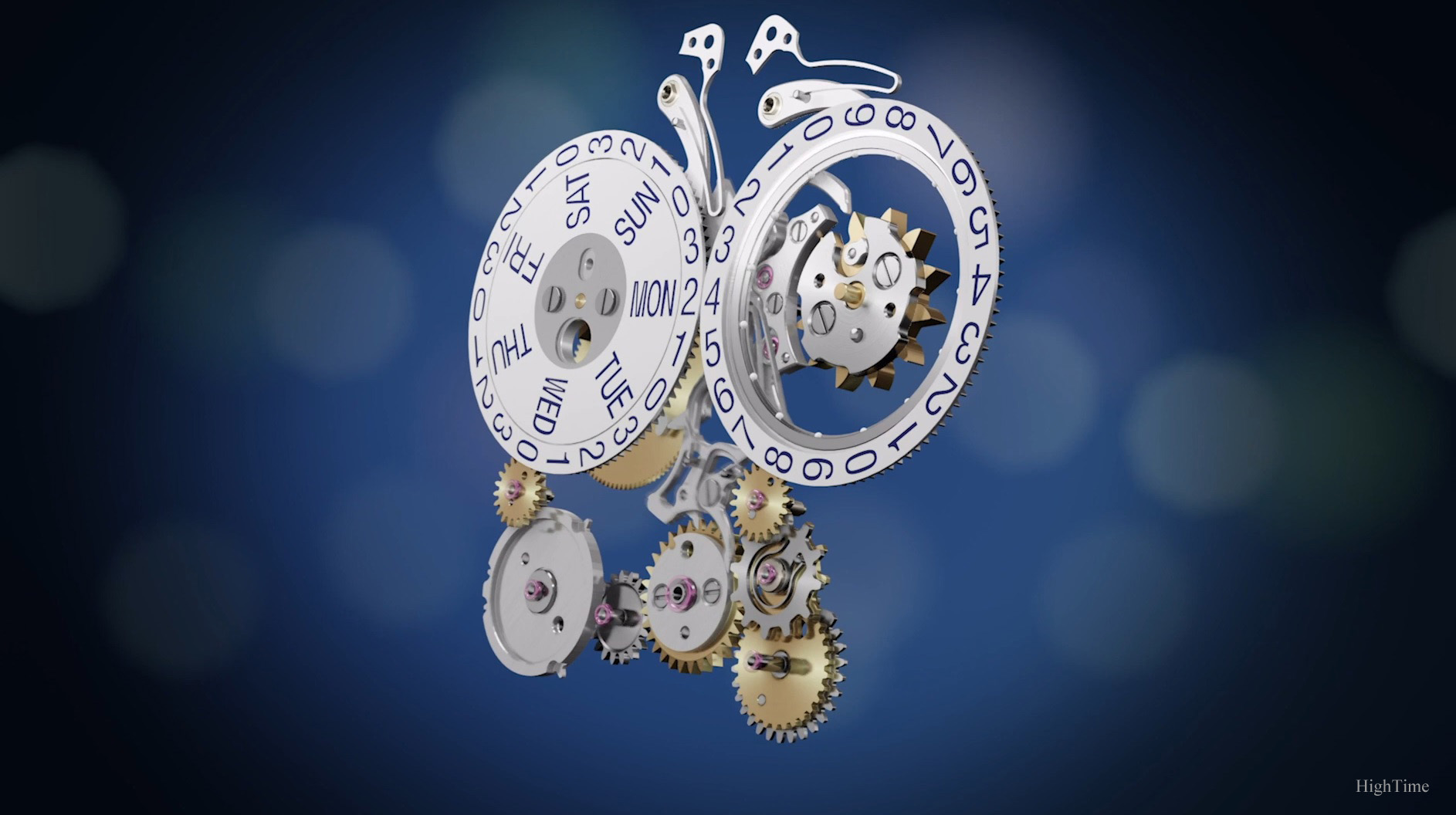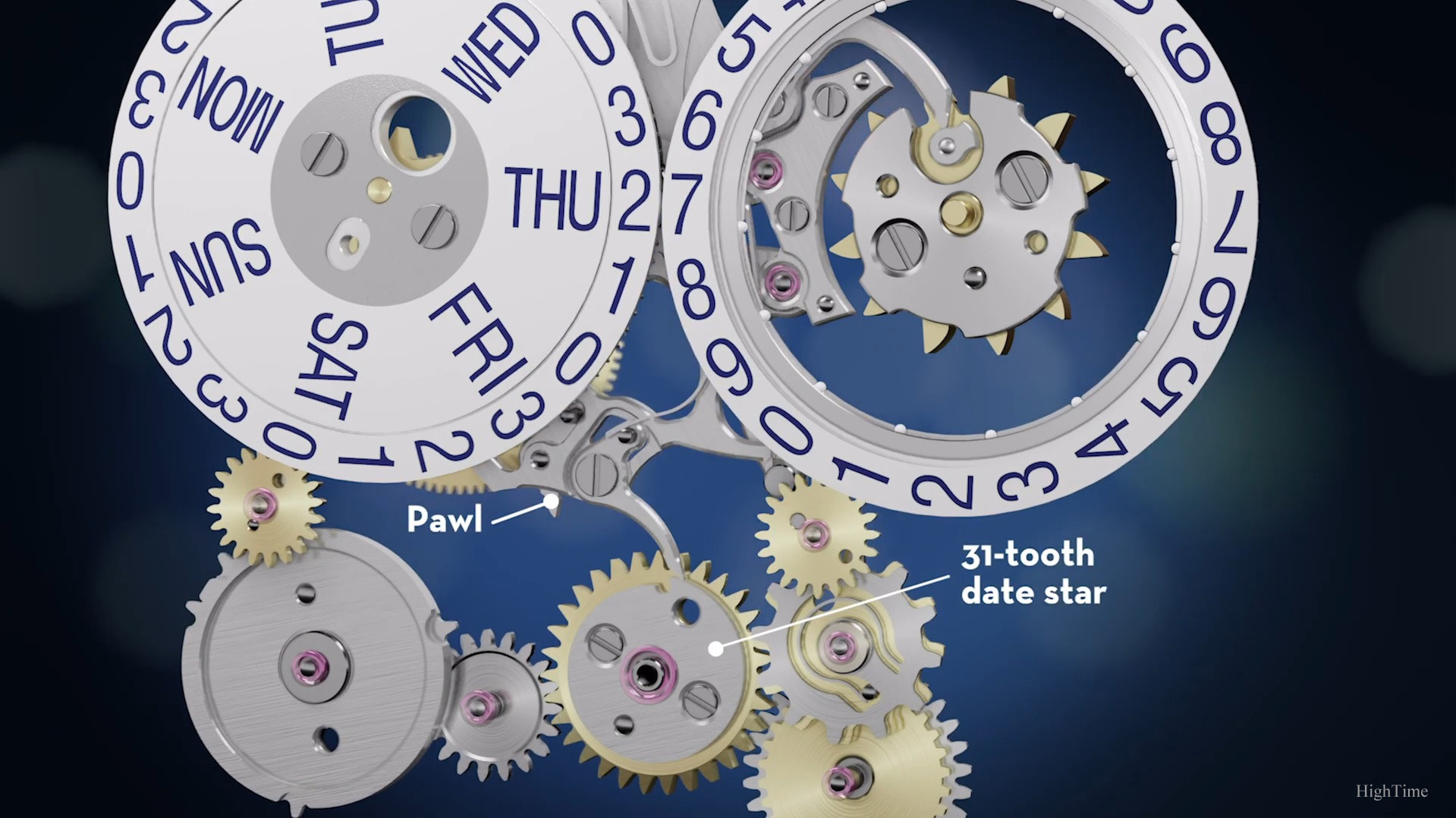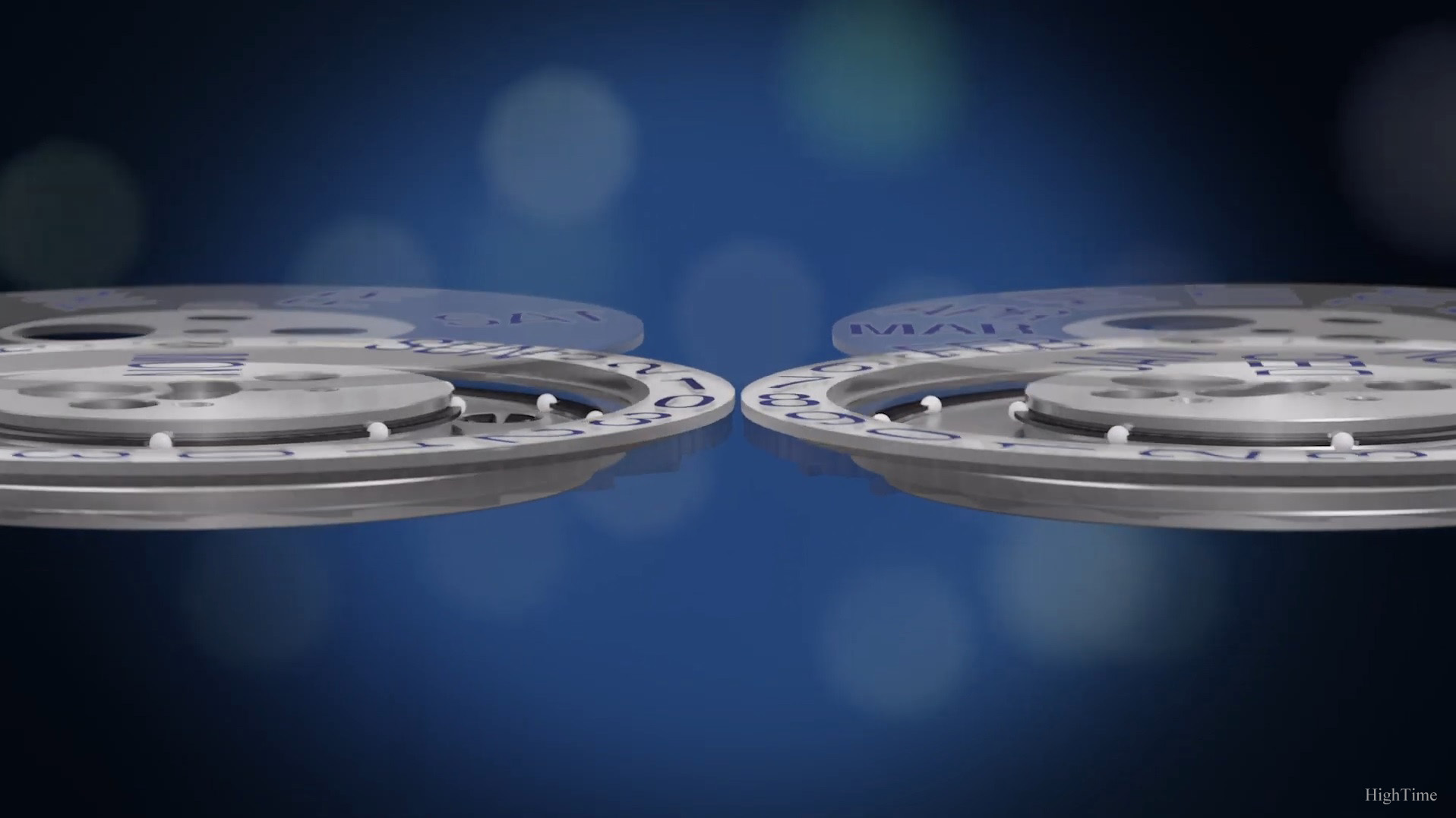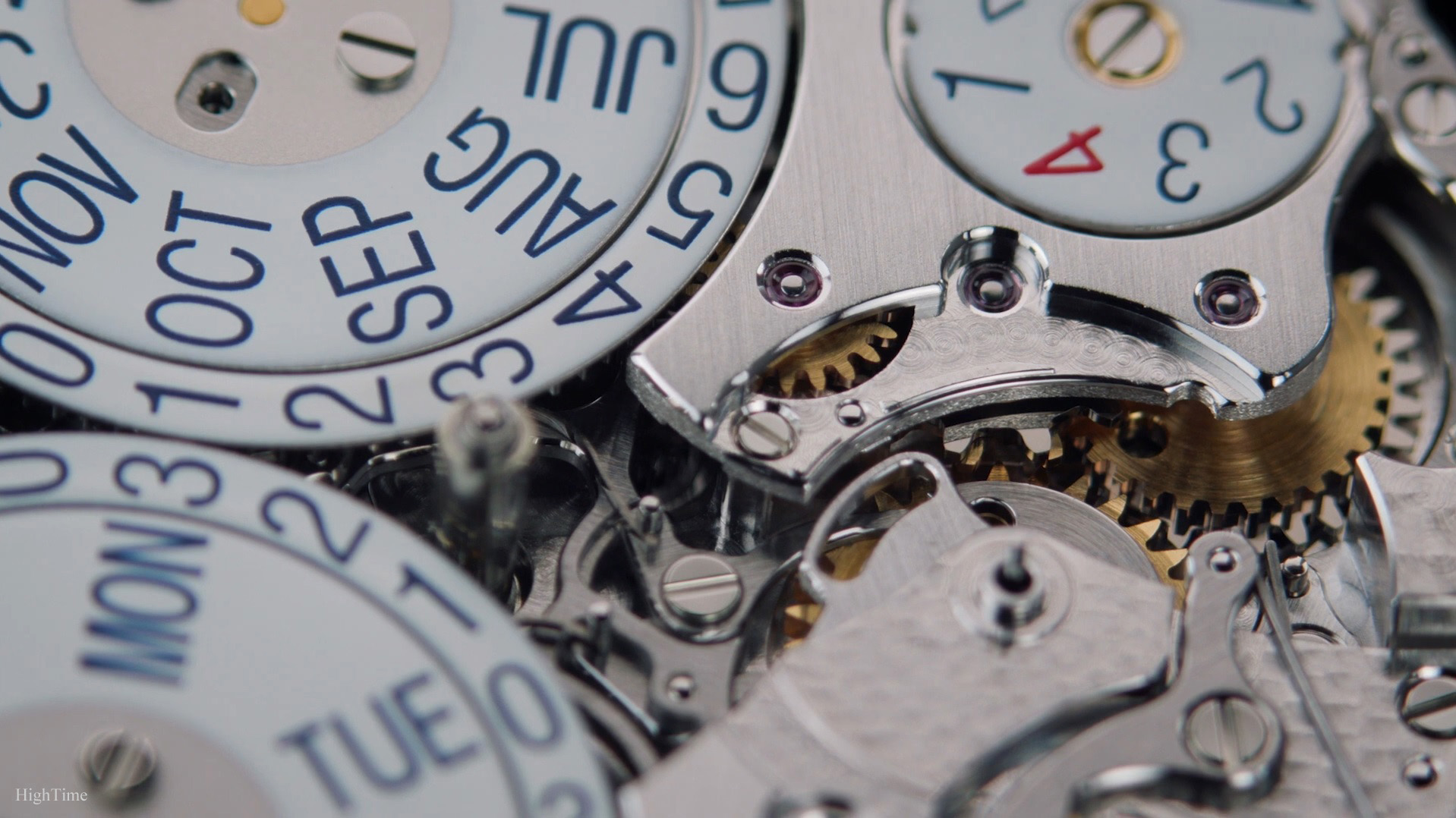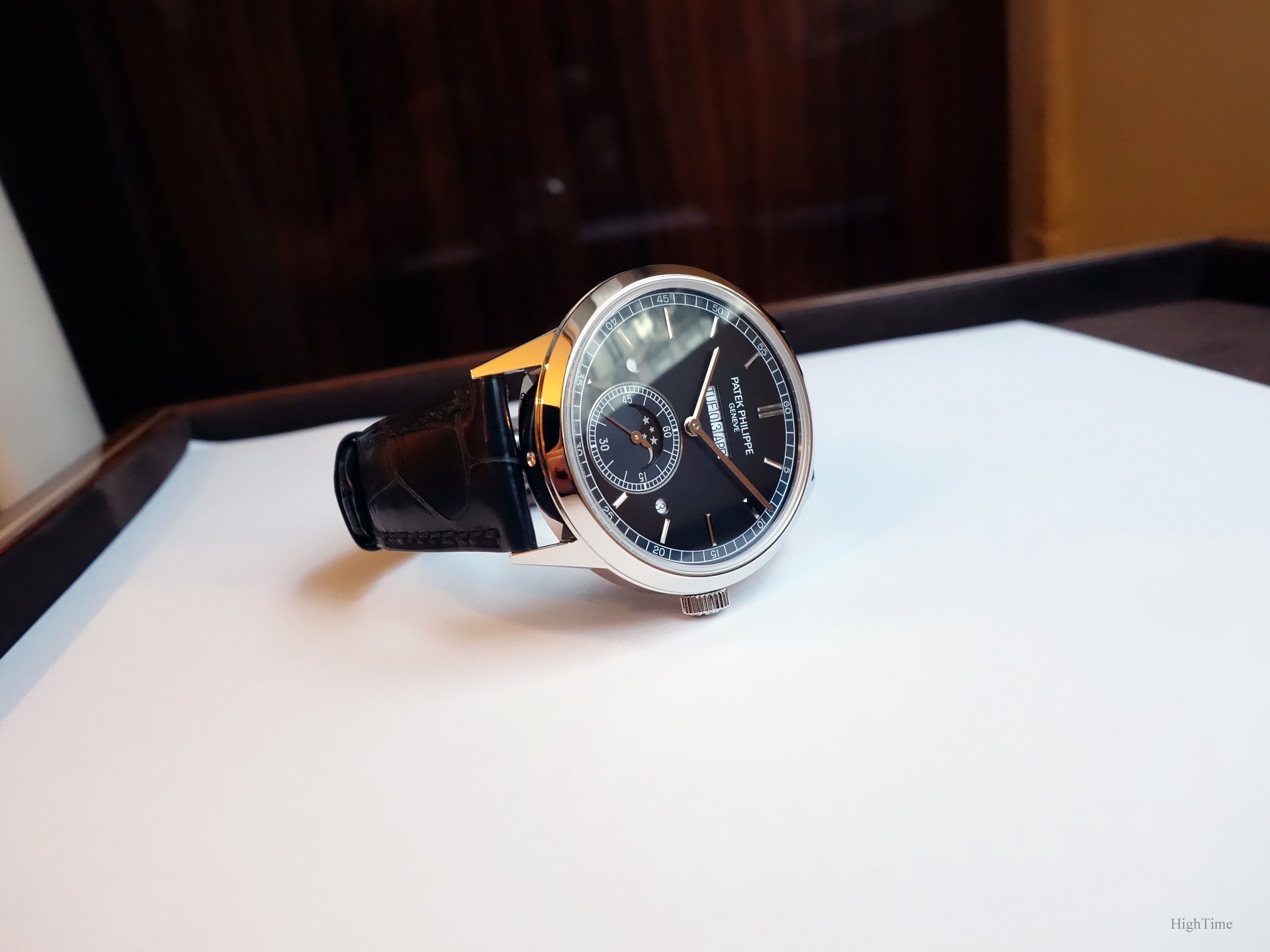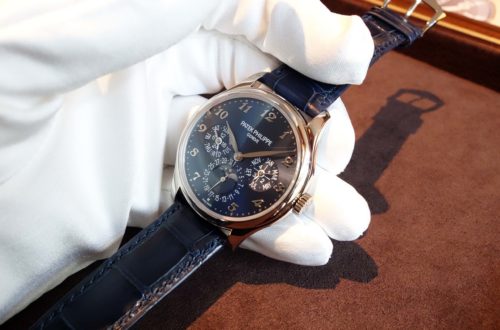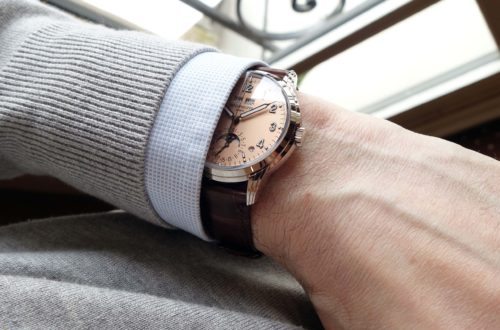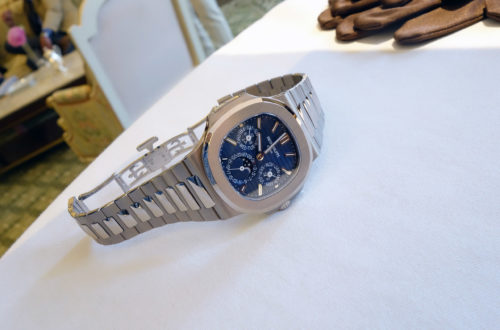The Patek Philippe 5236P Perpetual Calendar – Maybe their most beautiful modern QP
Hello everyone,
To me, one of the very attractive recent novelties was the launch of the new Patek Philippe 5236P “in-line” Perpetual Calendar. Indeed, a new interpretation of a QP (Quantième Perpétuel in French) from the brand is an event on its own, knowing its legacy, thus legitimacy. Furthermore, it was (at last!) the second introduction only of the gorgeous micro-rotor 31-260 caliber base, after the 5235 “Regulator” (2011). However, the main matter is maybe the fact Patek has created with the 5236P, the perfect interpretation of a new classics for our current era. It might be the way the brand is setting in a masterstroke a new standard of elegance fitting our times.
The experience was very enjoyable, especially since the official pictures are quite far from what I found in the metal. It says a lot about what the brand has undertaken recently and how it has evolved to be in line with our times.
This might have been overlooked, which is a mistake.
As far as I’m concerned, I got very excited. And there are solid reasons why.
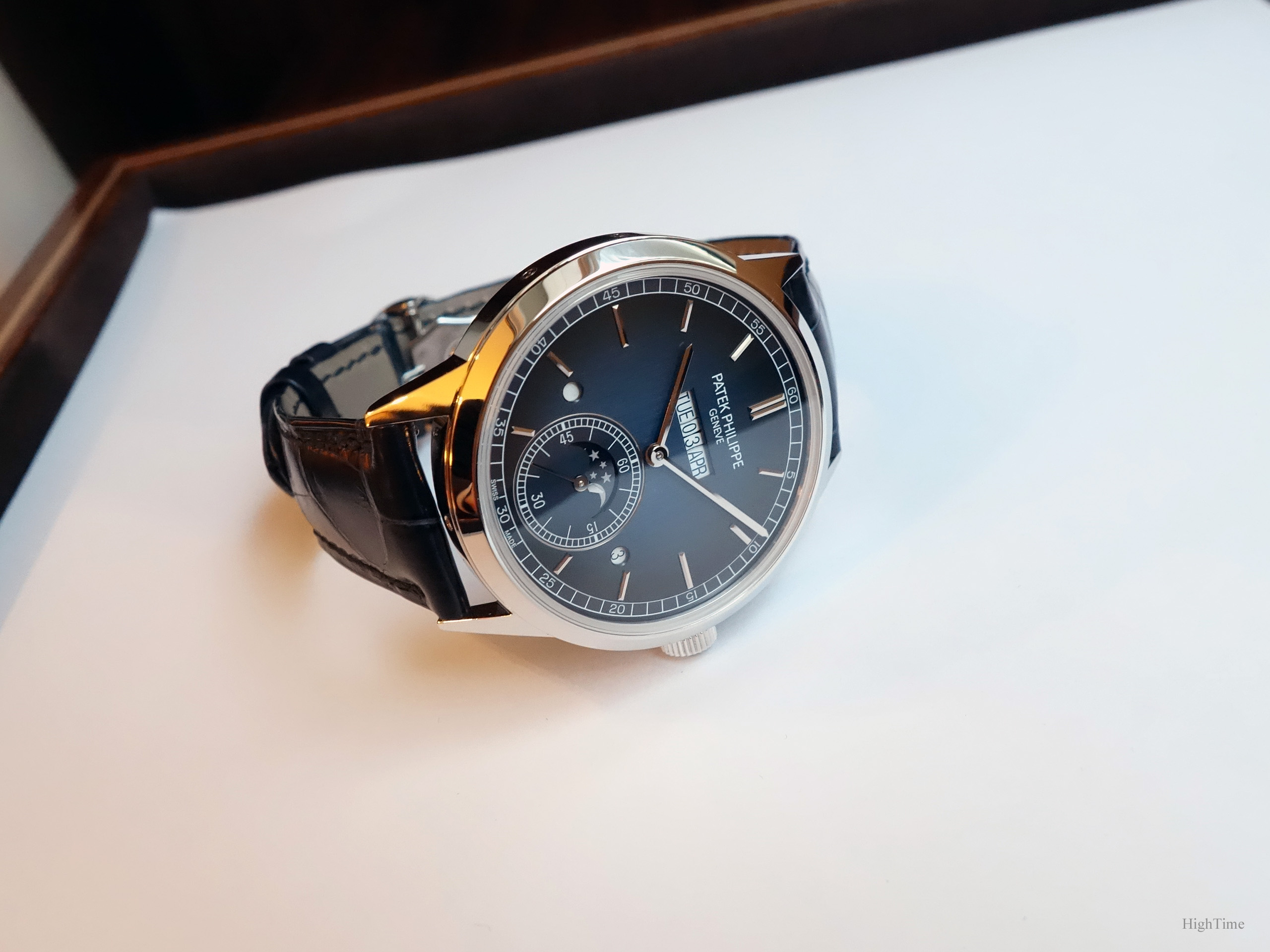
The 5236P in the Perpetual Calendar-only collection
We are on the presence of another wonderful rendering of the wristwatch QP complication. This mechanism is a significant part of why the brand is so highly esteemed today in the mind of watch enthusiasts and collectors. It already started back in 1925 for wristwatches.
As a quick reminder, not only a Perpetual Calendar recognizes the months in 30 or 31 days (like an Annual Calendar) but it also knows which date to display in February, whether it is a 28 or a 29 every 4 years. Hence, it skips the 29, 30 or 31 when needed, without any external intervention. Additionally, the way all date information have to move around midnight (and not progressively during the day) represents a significant difficulty in order to manage the energy consumption for it doesn’t disrupts timekeeping.
Historically, Patek has offered a large array of Perpetual Calendar displays that required to change (very significantly in some cases) the way it is designed or its complexity. Quickly, this is the previous PC-only references the brand has presented (without additional complication like for instance the chronograph):
- the 5159/5160 with 2 windows and their retrograde date (324 caliber);
- the 3940/5140/5327 and their 3-subdial arrangement (240 micro-rotor caliber);
- the 5320G with 2 windows and date hand, taking after the 3448/3450 models (324 caliber).
Here are the 3 formats illustrated:
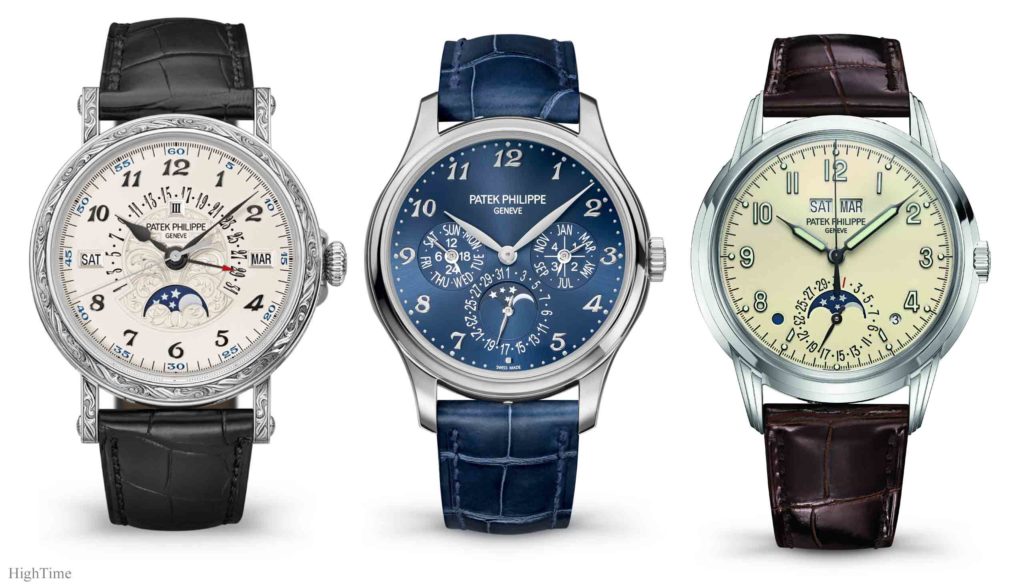
You may notice, not only the display changes but it is a different case family for each one.
Today, not long after the last 5320G, we are spoiled with an extraordinary (and superior) heir to the PC tradition with this 5236.
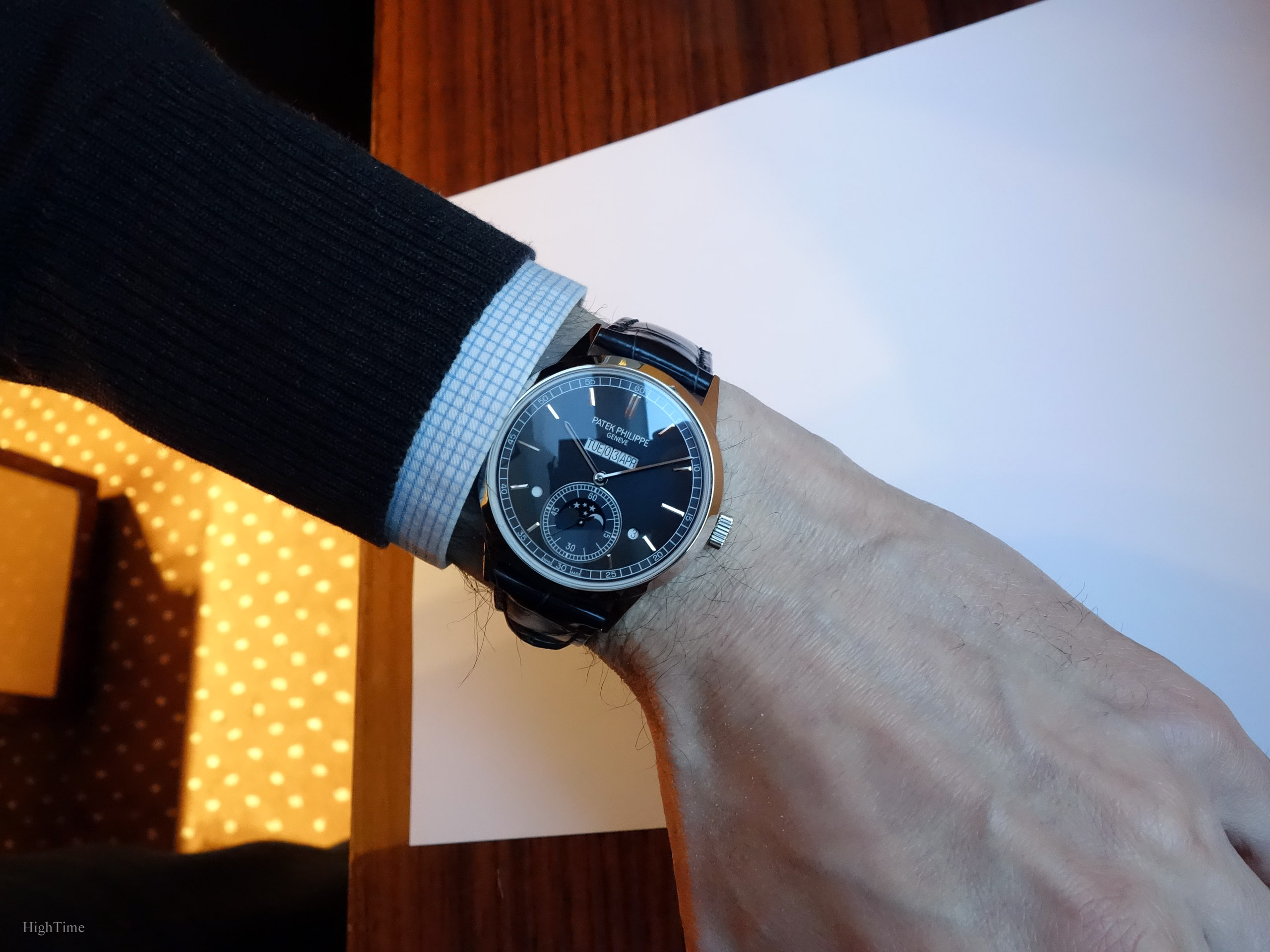
For once, I would like to explore the movement first, before the watch aesthetics, because it is a major difference with previous models (324 or 240 based) and what attracted me to this model the most.
The 31-260, the marvel of a caliber this QP deserves
… technically
It isn’t just a question of a new display format. The new single-aperture configuration is designed through a 4-disk mechanism: the day (1 disk), the “big” date (2 disks) and the month (1 disk). Its development was an adventure on its own.
Why not choosing a unique disk (with 31 days) for the date instead of 2? Because it would have led to less legible (i.e. smaller) figures. Indeed, the original pocket watch date aperture was 1.7mm tall. Consequently, this would have led to a 1.4mm size in the 5236’s dimensions. In the current 5236P, the window is 2.05mm tall, hence even bigger than in the pocket watch.
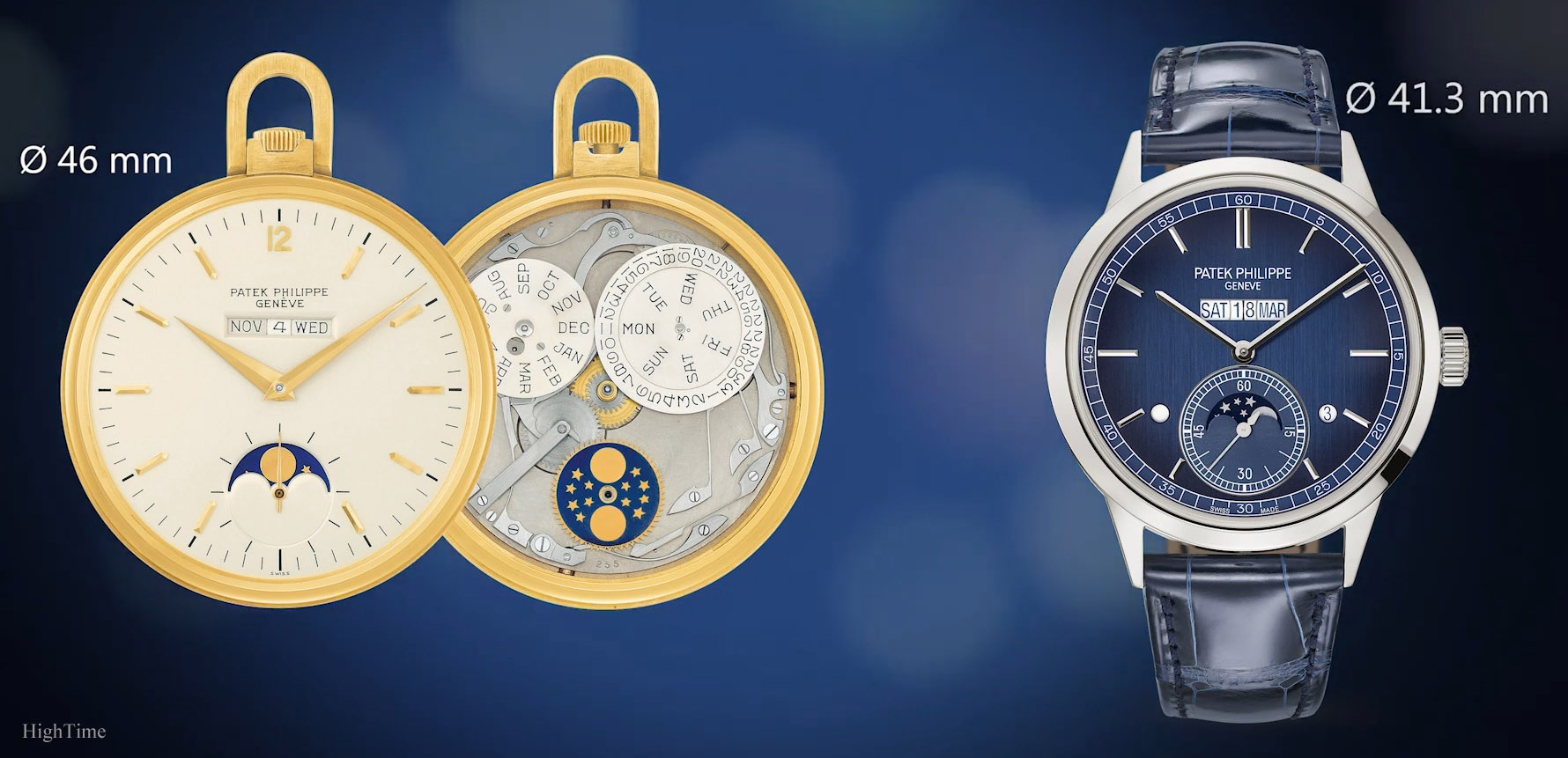
This choice suggests a preliminary well-thought energy consumption study. It isn’t spectacular, it is invisible on a marketing standpoint, but it is core to what watchmaking is about. This is the main guideline throughout le whole development of this caliber.
From its experience with many perpetual calendars in the course of its history, and especially the instant-jumping features inside higher-end references (5207 for instance), Patek has proven to know how to design such complex mechanisms. The complexity the 503 parts suggests (367 parts for the 5320G QP), including 298 parts for the QP-module only. As a comparison, the Grande Complication 5207 (Minute-Repeater, Tourbillon, Perpetual Calendar) has 557 parts and an A. Lange & Söhne Datograph Perpetual has 556.
This says a lot, especially considering Patek has proven aiming at simplifying functions as much as they can (29-535, 28-520, 5650G‘s 324 etc…). Like Colin Chapman Lotus motto “Light is right”, Patek endeavours to make smaller complicated movements. They bring more reliability, easier setting, smaller dimensions (which watchmaking excellence is also about), etc…
I imagine the higher number of jewels is included in the overall figure.
(nevertheless, let’s face it, increasing case sizes also push towards bigger movements as people like to see a “fulfilled” back side view. Even if the 31-260 is gorgeous that way, I usually don’t feel that way and for instance find the 27-70 in the 42mm 5070 perfect)
The date
Hence, the 4 disks displaying the in-line date, meaning in a very compacted way, requires much more research than just chosing “where are we going to put the date this time?”.
We’ve learned in the past that making “compact” is what they master and wish to preserve, from the 33mm Split-second 5959 to the recent 5930G‘s design.
For a Perpetual Calendar, the issue is to be able to store a very significant amount of energy. The small parts dimensions in such movements make that every small friction is “visible”. This is of course to be compared with the mainspring torque powering the whole caliber. The problem isn’t to be able to make the parts moving, it is to make them move without jeopardizing time accuracy. The balance wheel mustn’t suddenly loose amplitude because the energy is directed, for a few seconds or minutes, towards another function. Hence, a clever mechanism takes, in advance, several “small amounts” of energy (over several minutes or even hours) to charge a spring. When the spring is pressed at the required level, it switches the adequate disk or hand. In the 5236P, there are 4 disks to move, all gathered in the same place (this element is important). In a date-only function, there is only 1 disk/ring/hand to move.
By the way, in specific calibers, the pressure on some pinions (related to the tiny contact surface of course) can be sometimes equivalent to holding a bucket of water.
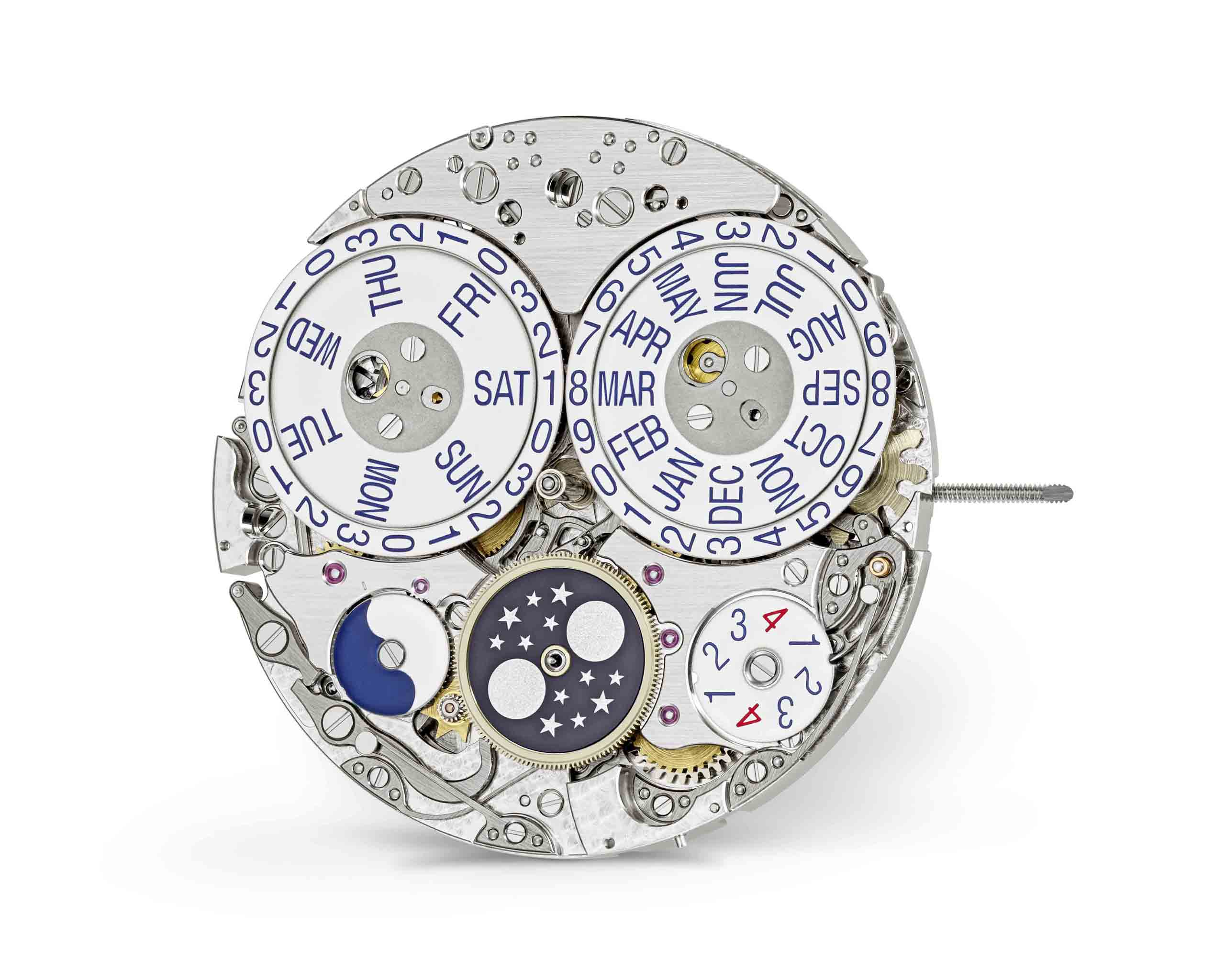
As a whole, it required 118 additional parts compared to a conventional QP display. Several wheels and bridges have been optimized to find additional consumption gains. In that regard, jewel bearings have been added where it wasn’t necessary in past references. The 5236P counts 55 jewels when the 5235’s caliber greeted 31 (+78%).

The date wheel is as usual at 6 o’clock. Hence, to bring the date up at 12 o’clock, we understand the gear train has to be thought differently to remain efficient, i.e. limiting the number of elements and limiting frictions.
By the way, wheel’s shape we are used to seing in previous QPs have been re-designed and improved, like the Month and Leap Year elements (pictures below). Moreover, let’s add they are aesthetically much more appealing, especially considering enhanced finishing.
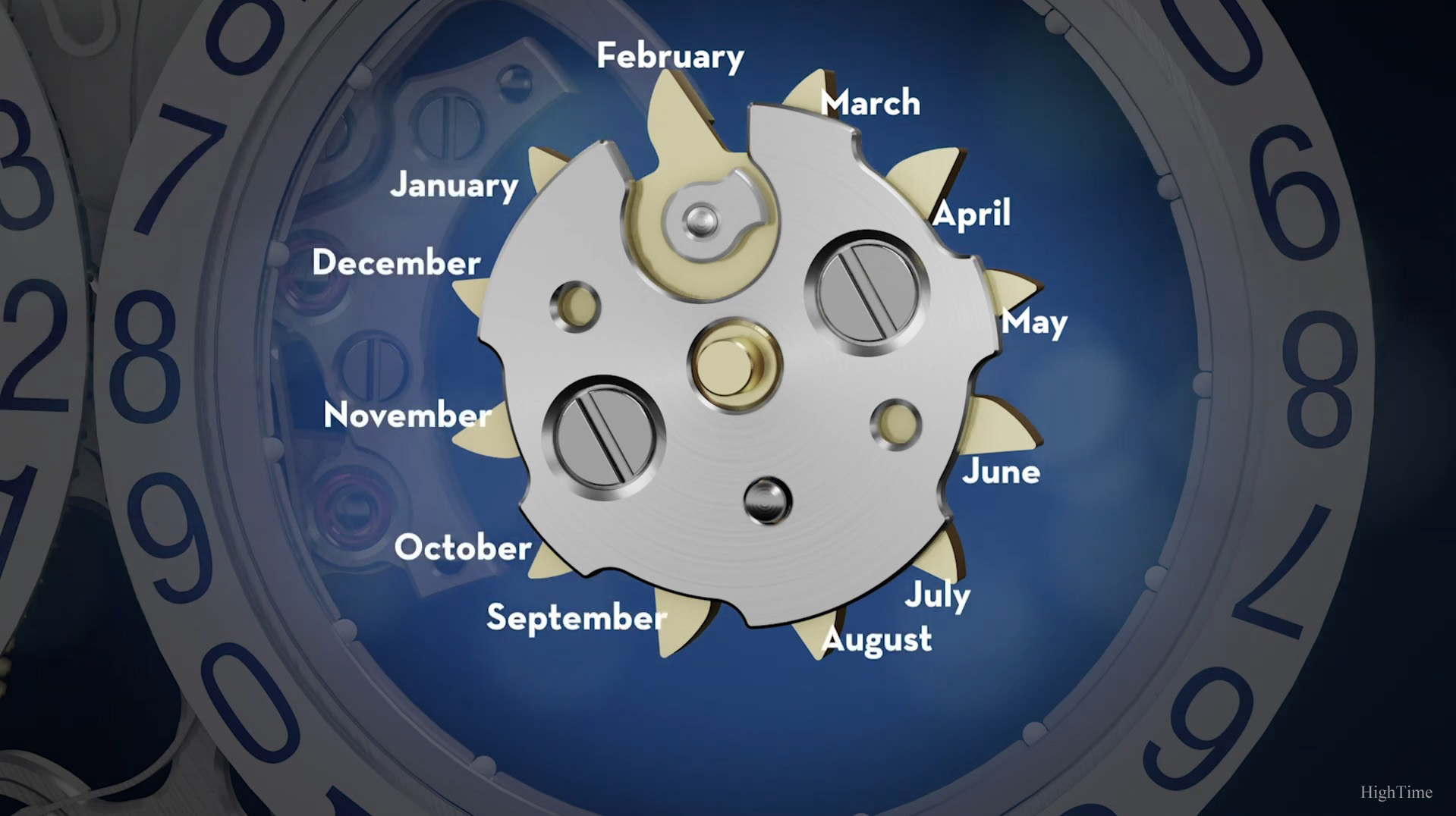
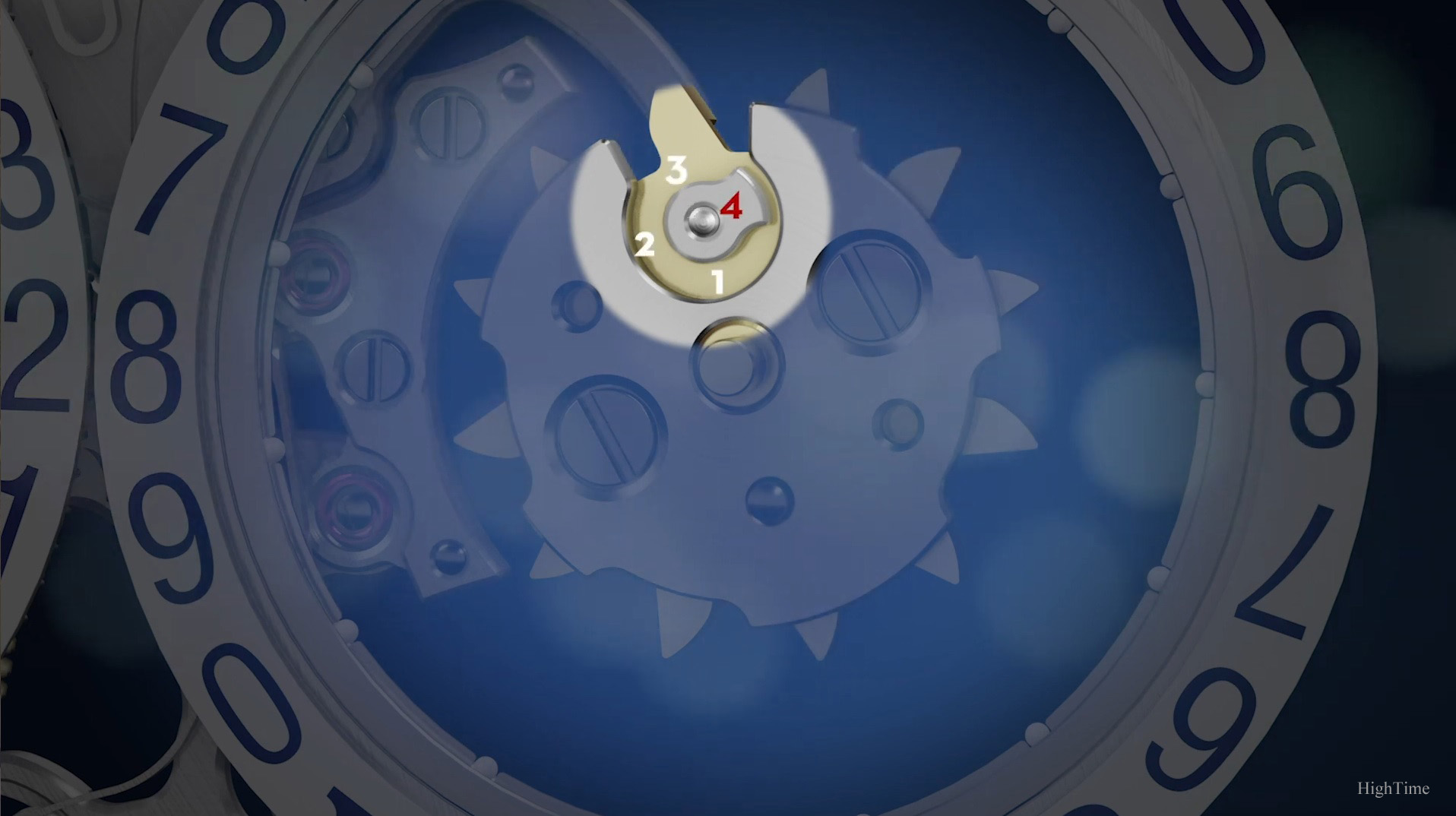
The disks mechanism is arranged with the support of 2 coplanar double ball bearings allowing to allign the day-date-month information (1st patent application). The 4 disks are designed to remain on the same plan (while on a Datograph for instance, 2 disks are one above the other).
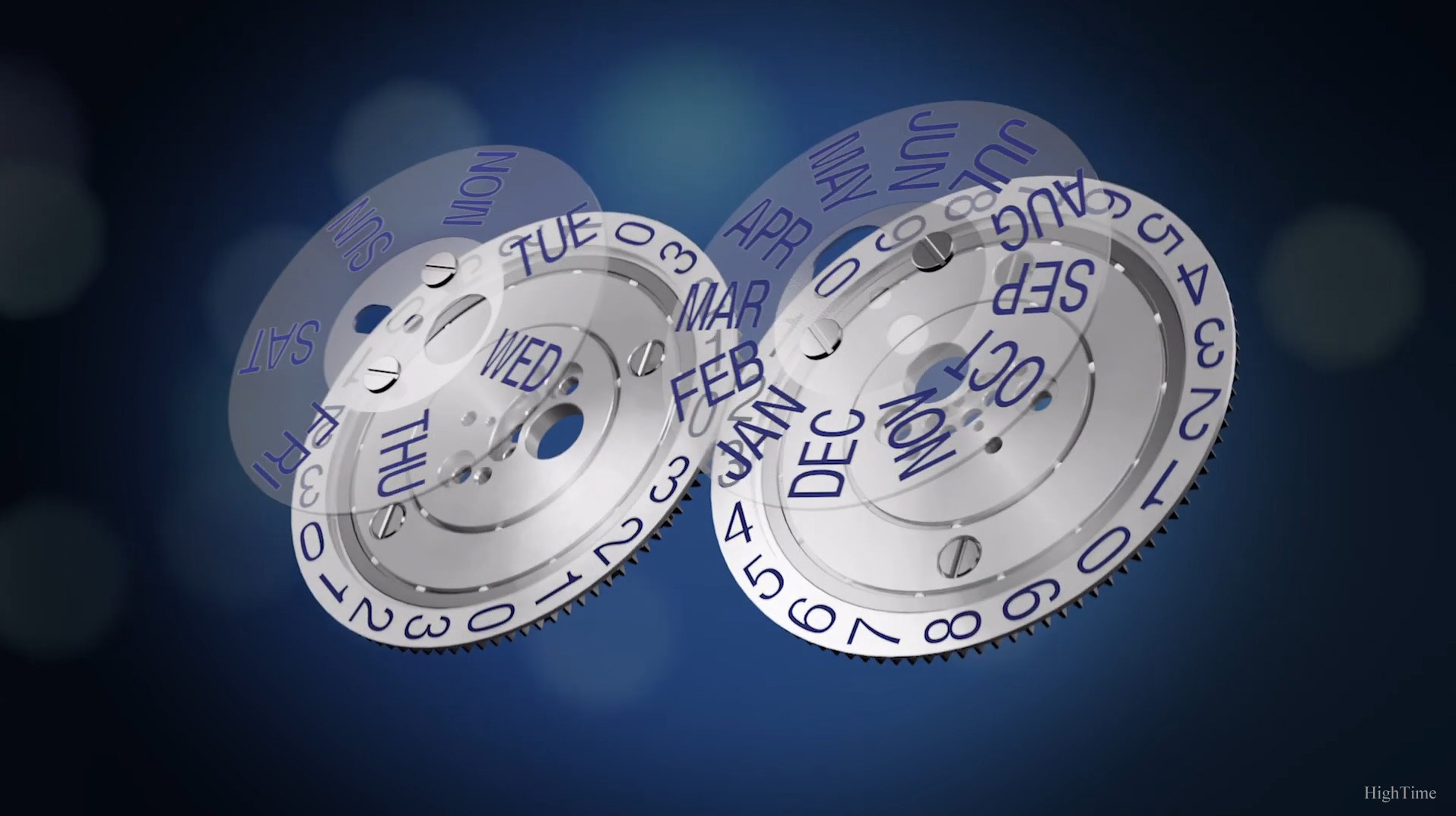
On the previous and next pictures, you can notice the intermediate ring is screwed on the movement. Hence, the central ring (which holds the days/months sapphire disk) and the external ring (which holds the units/tens disk) are “suspended” by their ball bearings.
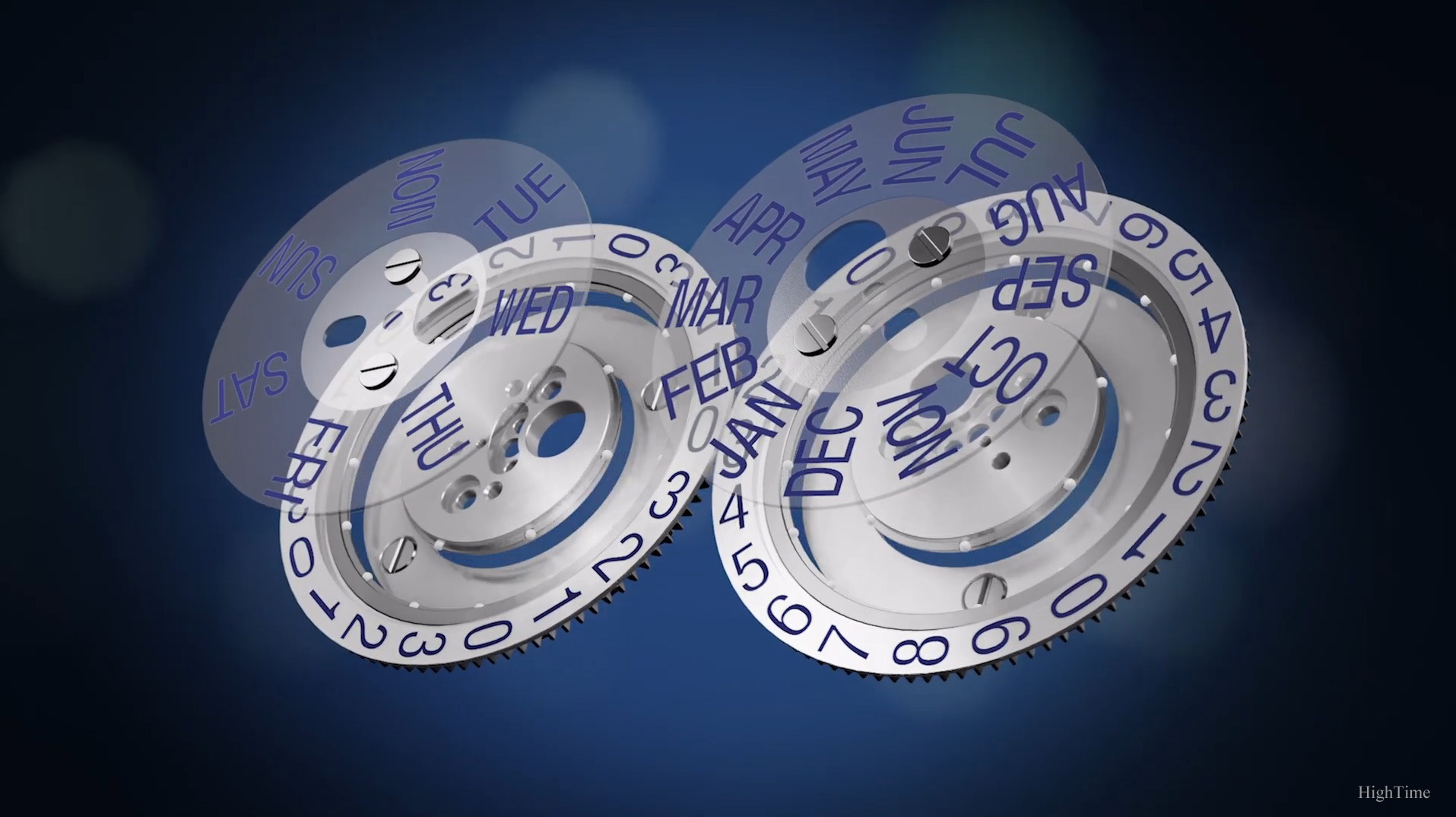
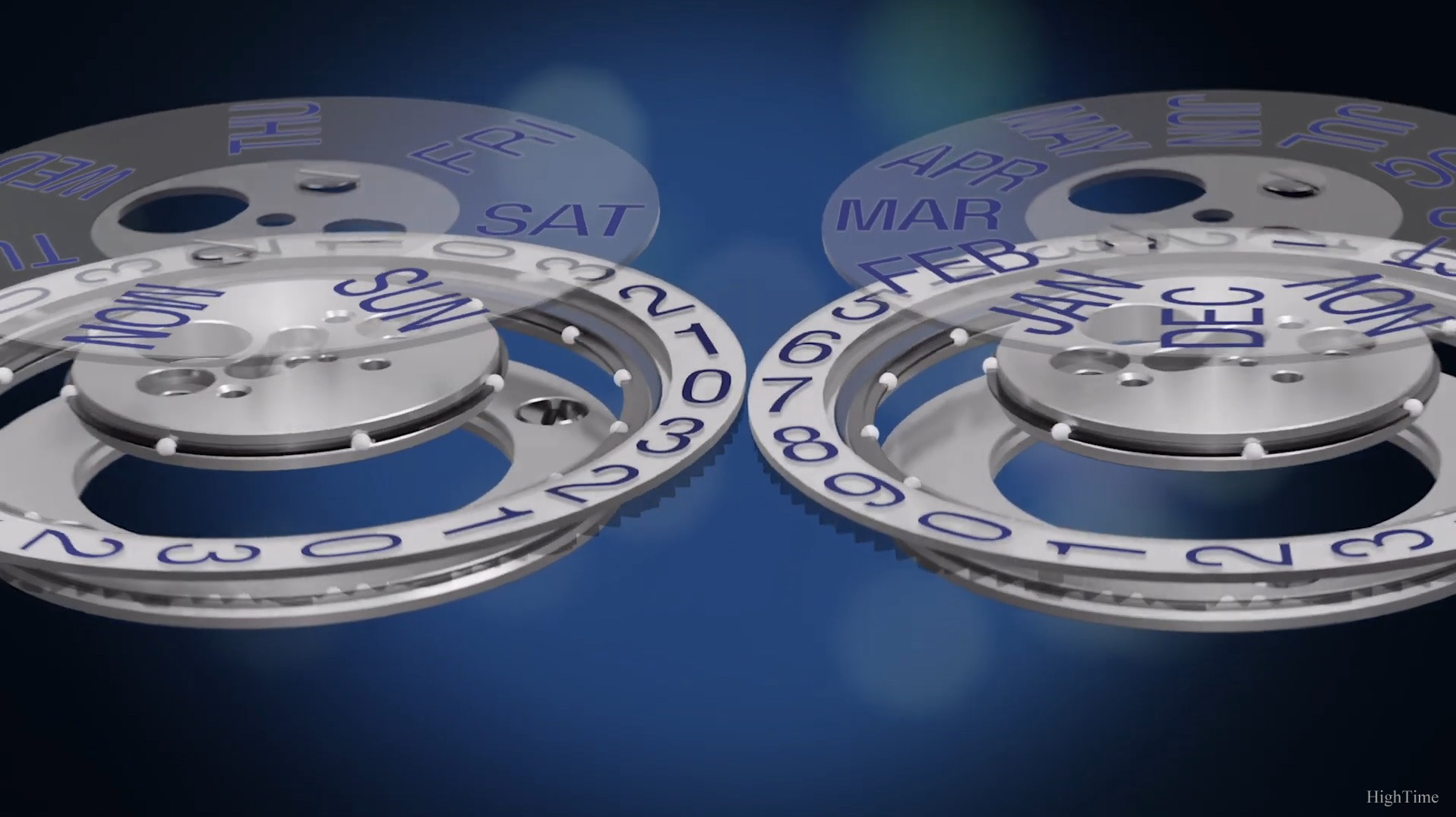
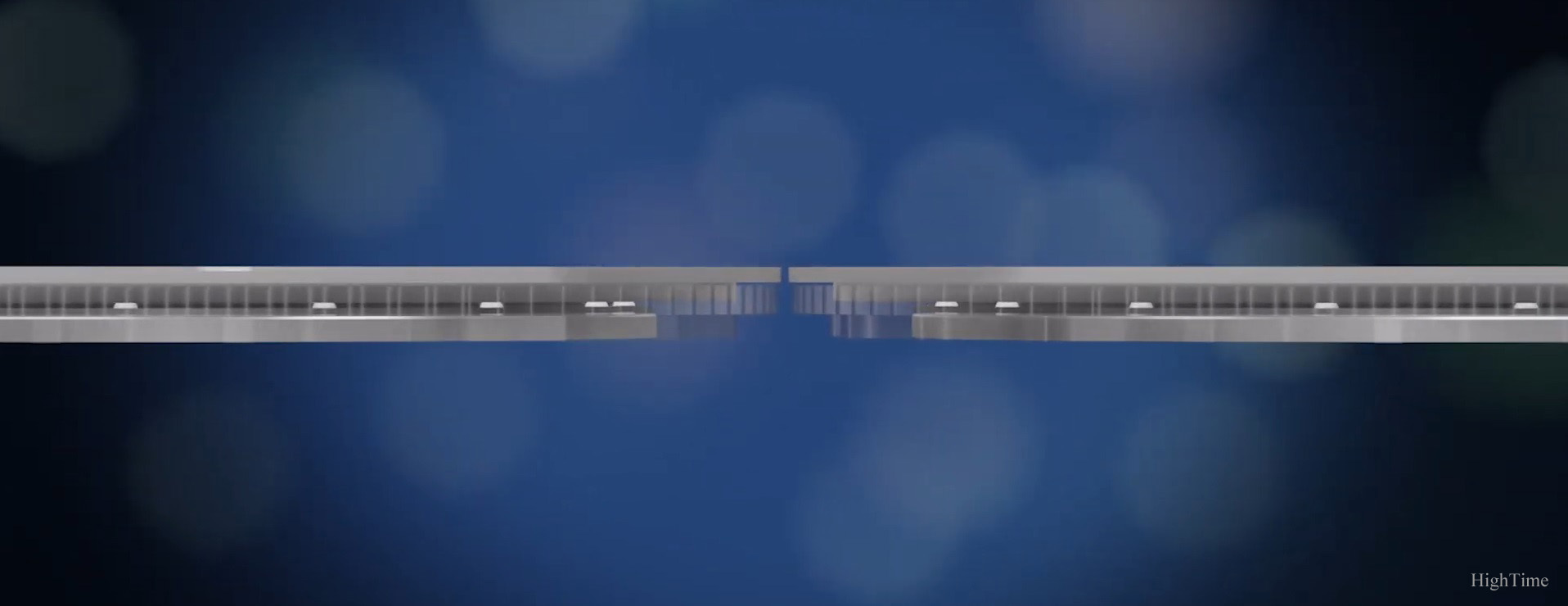
Those disks have to be perfectly tuned in order to be synchronized and upgraded for they don’t make a “double-jump” when activated during the night or in case of a shock (2nd patent application). One example below (with the units disk): the A star (linked to the disk) is blocked by the B wheel. It is inspired from the “surprise” piece included in Minute-Repeaters.
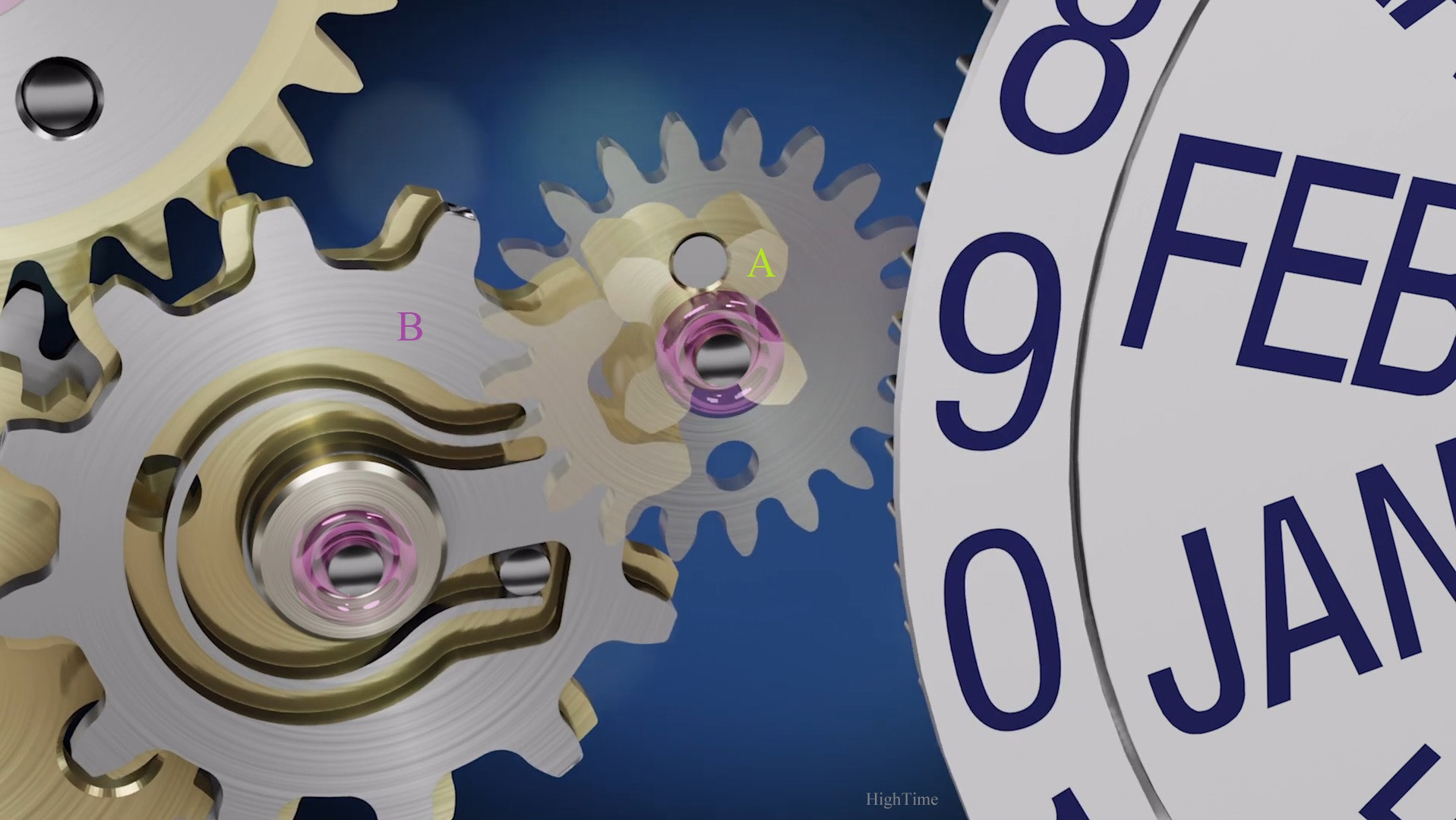
The 3rd patent deals with the way the date units disk is immobilized when switching from the 31st to the 1st of the next month.
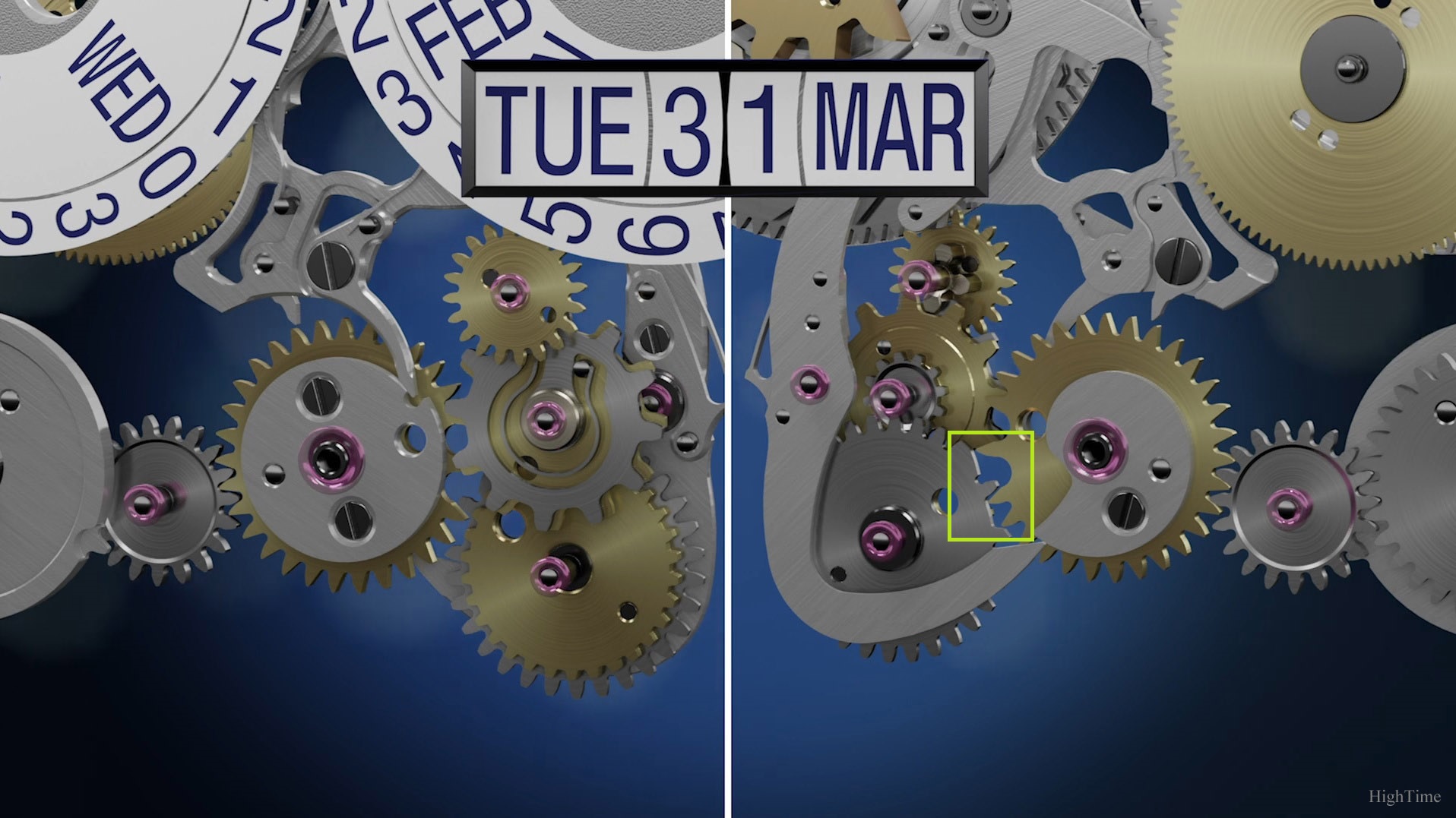
The brand explains the calendar module (3.2mm thick) has its own plate which means it isn’t integrated together with the 31-260 caliber base (2.6mm thick), allowing a slimmer movement (hence a mere 5.8mm). To understand what this 31-260 QL caliber represents in terms of development, the Calendar module in the 5320G is 1.65mm while its 324 base caliber is 3.32mm (hence a 5mm overall).
We often learn that, for similar functions, Patek sometimes find that doing differently optimizes the movement. It was true for the 5172 vs 5320 case construction for instance. It shows the easy way isn’t always favored as far as this brand is concerned.
In this regard, the minirotor is closer to the balance wheel compared to the 5235’s version. Elements have moved and this version isn’t based on a plain copy of the 5235’s. Exactly like with the 28-520 inside the 5930G that has been modified since the 5960 for instance.
Elsewhere
The torque of the mainspring (inside the single spring barrel storing the energy for the watch) was increased by 20% to fuel the Perpetual Calendar function. In addition, the minirotor is in platinum (on the contrary to the 240 caliber’s which is made of 22k gold), slightly thicker, hence increases its (unidirectional) winding efficiency (more inertia), more adequately for a complication requiring a little more energy.
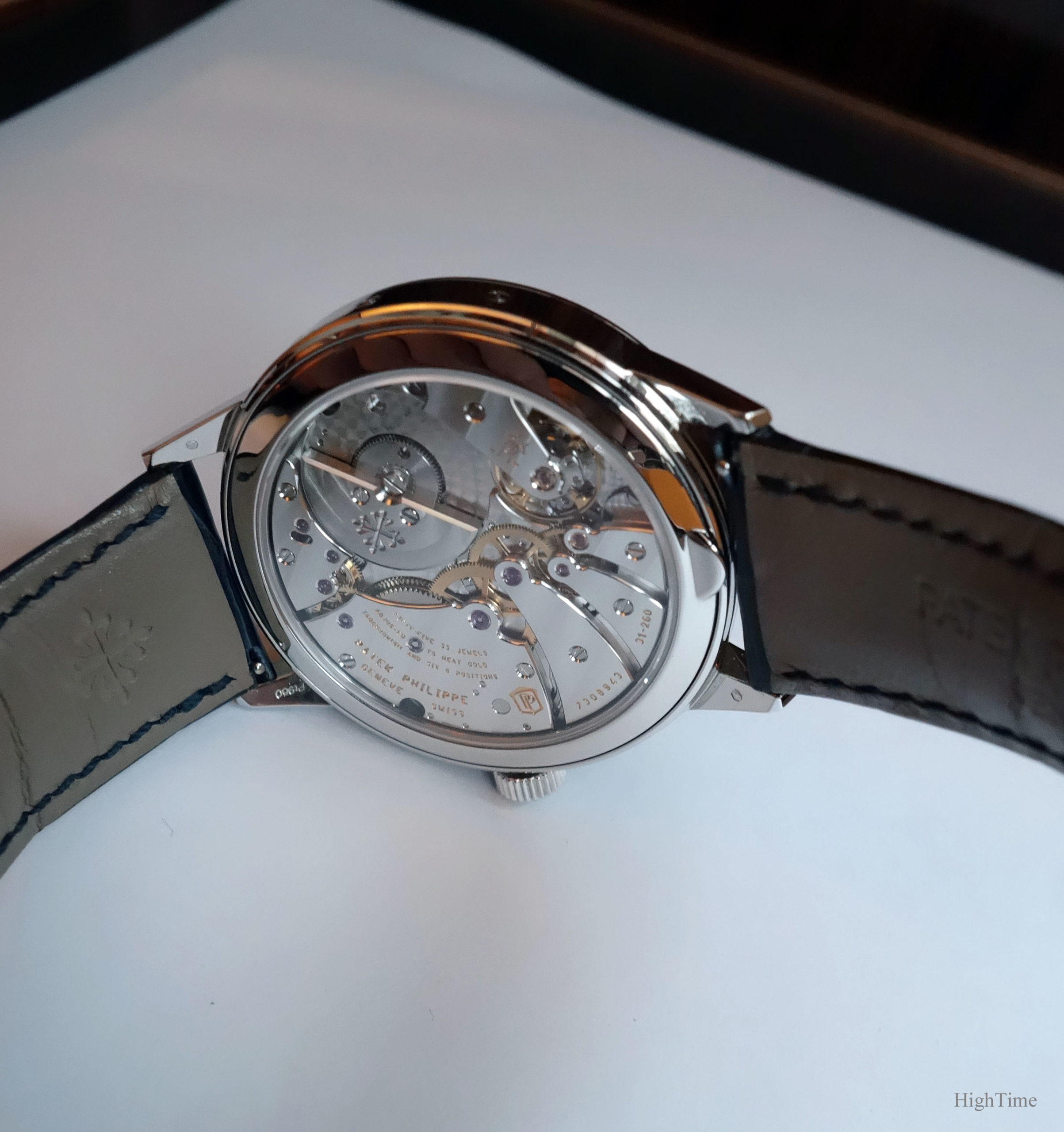
As for the frequency, while the 5235’s 31-260 beats at an unusual 23,040 vph (3.2 Hz), this 5236P version stands at 28,800 vph (4 Hz). The higher rate makes the pace steadier during day life (higher speed => higher inertia) and is tuned to a no-Pulsomax caliber. However, it receives the Spiromax balance spring made of Silinvar (Silicon-based material, anti-magnetic, no lubrication needed, temperature low sensitivity).
In the end, the power reserve stands at max. 48 hours which is standard for an automatic Patek QP in spite of the specific Perpetual Calendar configuration. Again, Patek prefers to improve accuracy over power reserve (like for the new 26-330 caliber replacing the 324).
Like for the new 26-330 caliber, the winding mechanism is equipped with a new reduction wheel: it disconnects the automatic winding mechanism when the watch is manually wound to limit wear and residues.
Finally, the movement is equipped with a hacking second feature.
… aesthetically
This 31-260 PS QL version (PS for “Petite Seconde”=small second and QL for “Quantième perpétuel en Ligne”=In-line perpetual calendar) is absolutely gorgeous and brings the QP model to another level since the already excellent 240 caliber.
The 31-260 caliber base (launched in 2011) is already a beauty on its own. Nevertheless, the way the bridges have been adorned for the QP complication makes it even more beautiful. I think that, in a world where we maybe tend to pass a little too quickly on things, not giving the proper amount of time to observe, this can be missed. It is especially true considering what Horology can give (the new manual 30-255 introduction was discreet too, to say the least). If you are reading this blog right now, it might be something you also like to enjoy.
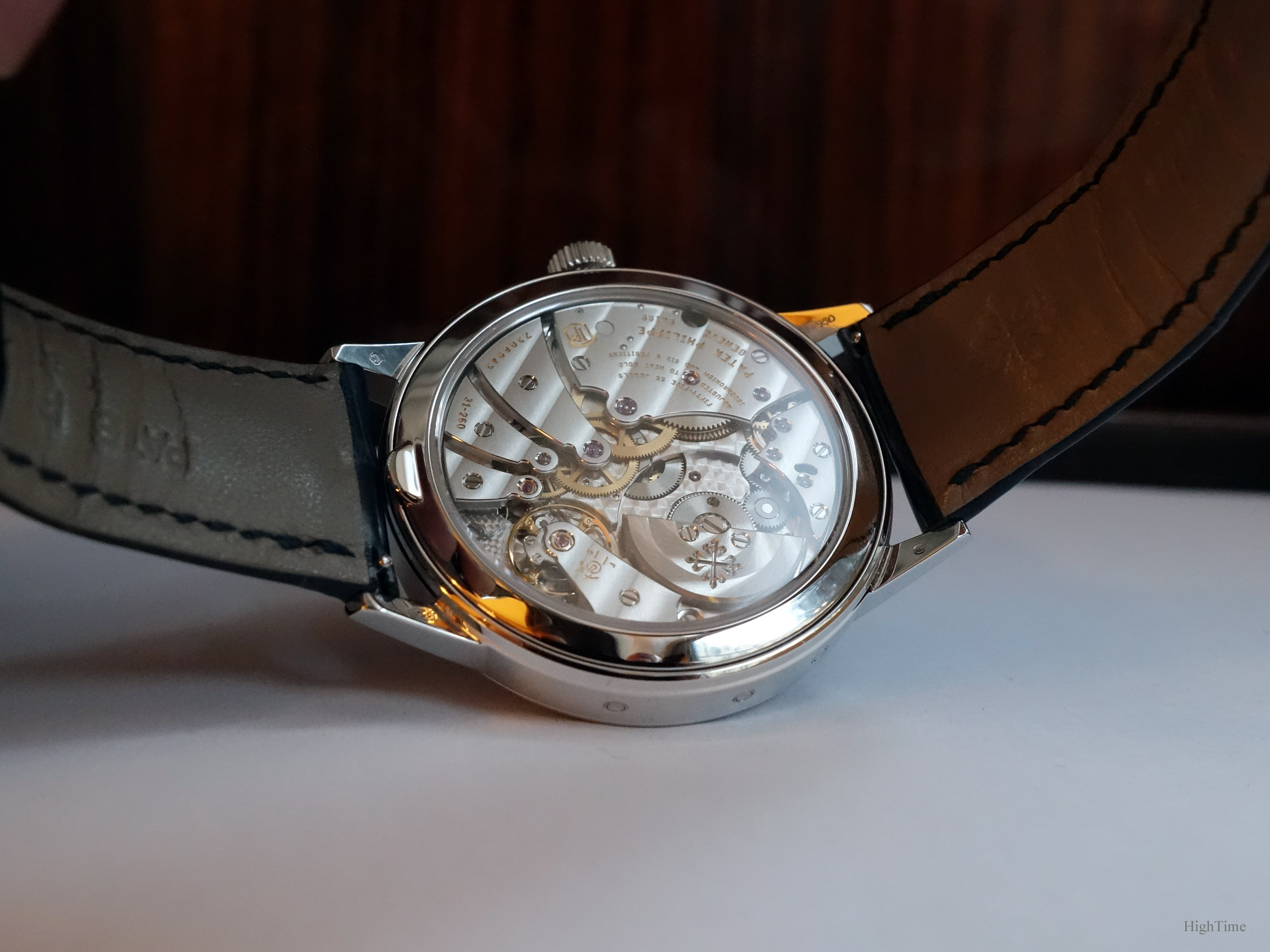
As you see from the mirror polished pinion holes, the shapes are more elaborate, the length of the edges is increased, hence it requires more time to polish. You can notice in the movement dial-side picture posted (hidden from outside) that it is finished at a high level nevertheless.
Here, the bridges are quite different from the 31-260 included in the 5235 Regulator (Annual Calendar). Indeed, you can have a look at the comparision picture further below, showing those 3 “coq” individual bridges on the 5236P (left) compared to 2 wider plate bridges on the 5235 (right).
Those 5236P’s “individual” bridges cut and overall look construction, roughly 1 bridge for 1 wheel/pinion spirit, is outstanding especially today when movements are often simplified in terms of shapes. Indeed, in theory, a wide single plate is more rigid and offers less edges to finish. Hence, choosing multiple smaller parts instead requires quite a sum of extra work.
Furthermore, have a look at the other bridges plates, how they receive some “twisted” edges, around the pinions holes. There are sharp endings here and there, instead of round shapes that are less complex to finish and less time consuming. It is clearly illustrated in the picture further below. This is also visible next to a 324, 240 or even a 5235 Regulator’s 31-260 caliber.
It’s a no-shortcut way and the result, as you understand, is more appealing. This was a uniqueness this QP offered until the 5326G unveiled in 2022, pushing further what Patek think they should provide for such elaborated models. The other minirotor movement used for their QPs is the 240 caliber. This 31-260 shouldn’t be overlooked, considering the habit we might get from seeing so many novelties each year. I had a look at some established brands providing QP-only models (in the metal, not on photos) but they don’t come close to what is done here (even next to the 240 for most of them). A quick “visit-check” would illustrate that today and show why Patek stand where they stand.
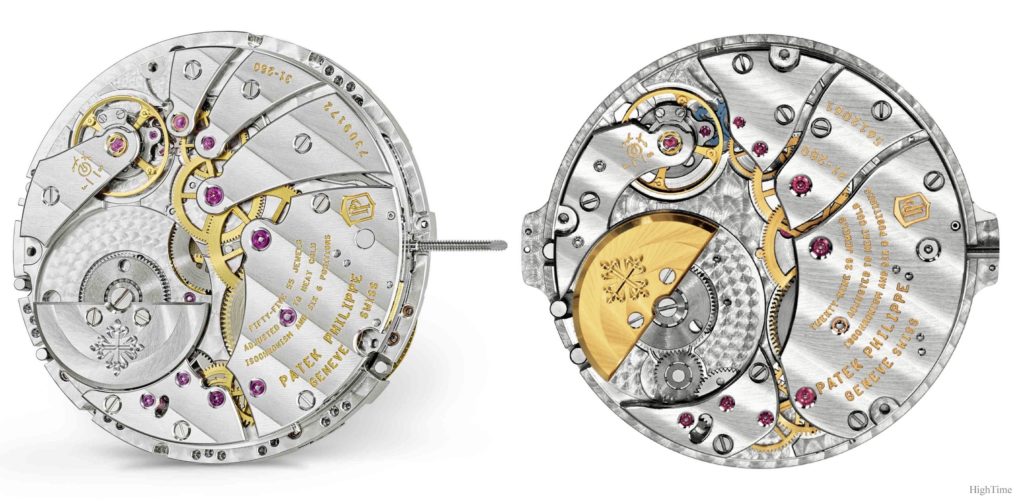
Another detail to mention: the Geneva stripes are harder to apply on several bridges (versus a larger plate) as these stripes have to be perfectly aligned. The 31-260 caliber showcases this decoration beautifully and elegantly.
As far as Patek QPs are concerned, it has rarely (never?) been available at this level before. A quite significative craftmanship superior work is offered to the owner of this very model. One of the explanations being of course the 5236P’s higher price point.
This “individual bridges” philosophy reminds me of the illustrious 12-400/600 or 27-460 older calibers (latter pictured below, used in the 3448/3450 for instance over the 1960’s-1980’s period) that collectors have in their heart. I find it very pleasant to have a look back that way… This is what we should expect from such brands, especially considering their price.
Though the 27-460 (same for the 12-400/600) shows 2 beautiful additional inward angles (picture below), you will notice the other 31-260 bridge edges on the 5236 show much more elaborate surfaces (more and sharper outward angles, complex curves here and there), hence quite a load of additional work on the latter. This shows that Patek has provided very serious performance for this movement, especially since the 240.
On internet, comments on calibers (whatever the brand) are sometimes quick to mention lack of inward angles but this overshadows the rest, whether it is aesthetical or technical improvements and working performance. On the 31-260 caliber, I perfer its impressive curve complexity and the way the overall creation is rendered to an inward angle that would have been included in a 240 caliber for instance.
This being said, if Patek could provide them as well, I wouldn’t refuse it…
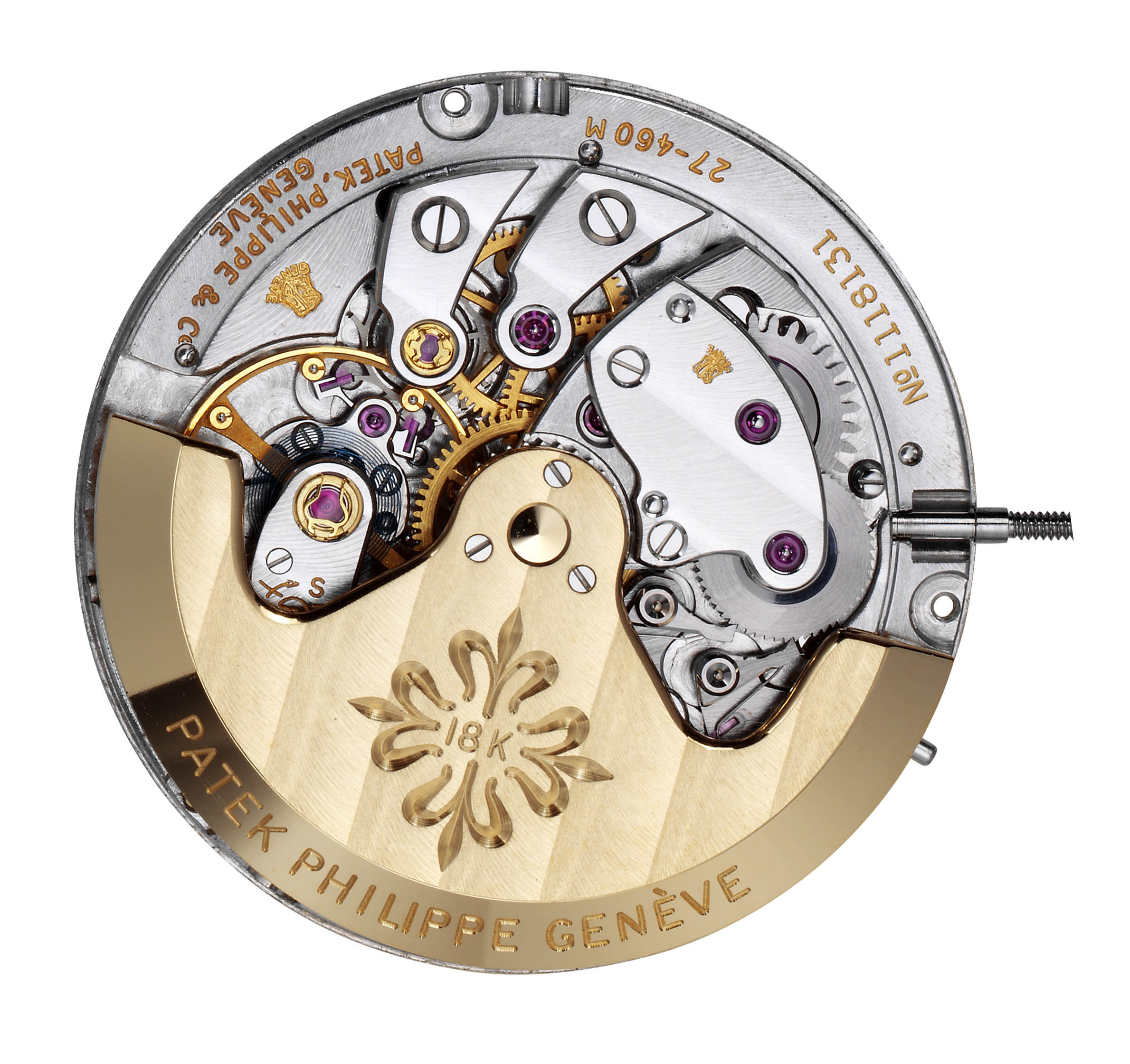
In the past, the 240 caliber (minirotor as well, picture below) was offered in a wide range of complications. It was of course very different times when the 240 (unveiled in 1977), being at the time part of the finest automatic calibers (thin, reliable, nicely finished), could be proposed more widely.
Back then, we observed that competitors included much simpler calibers in terms of design and decoration (and many still do so today). They were by the way often sourced from other manufacturers. It was a time when brands and clients weren’t paying much attention to the back side of watches (not many see-through casebacks before the 1990’s). In that context, we can feel that the in-house 240 arrival was a major breakthrough in providing a movement worthy of high-end status.
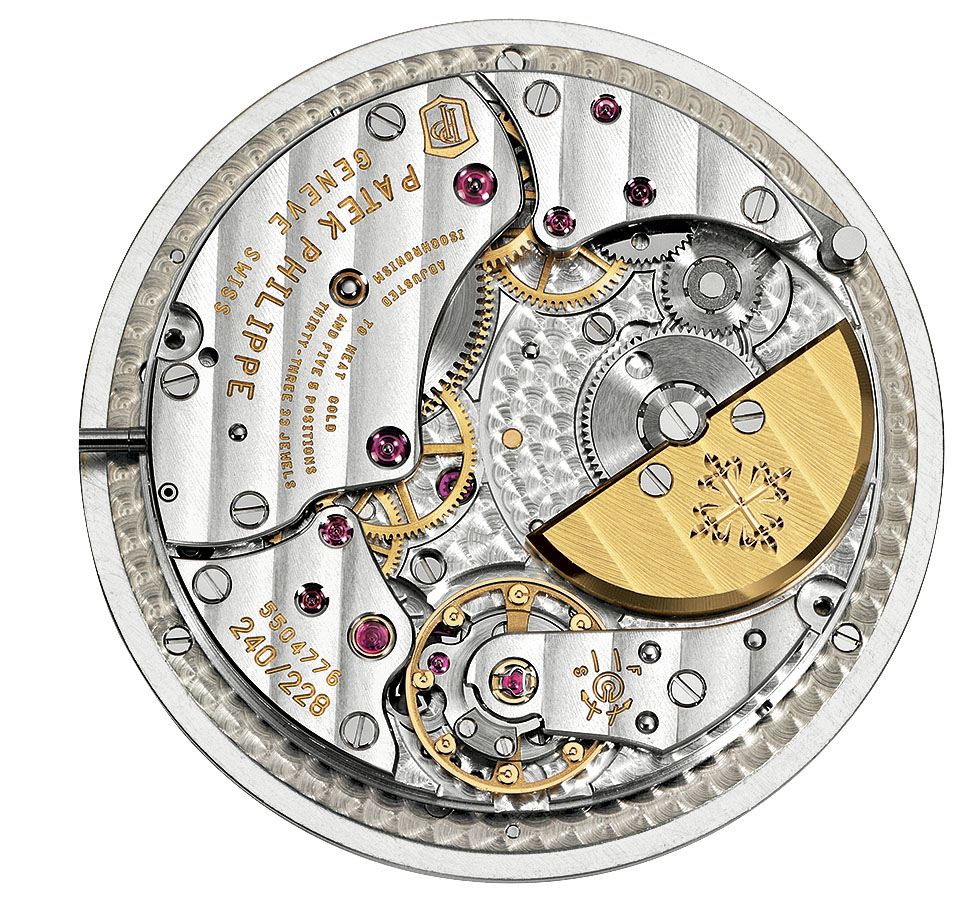
It was a chance to obtain the 240 from the less complicated references (e.g. the World-Timers or the 5712) to QPs or the 6102 Celestial. It has then become a “legend” in the brand’s history.
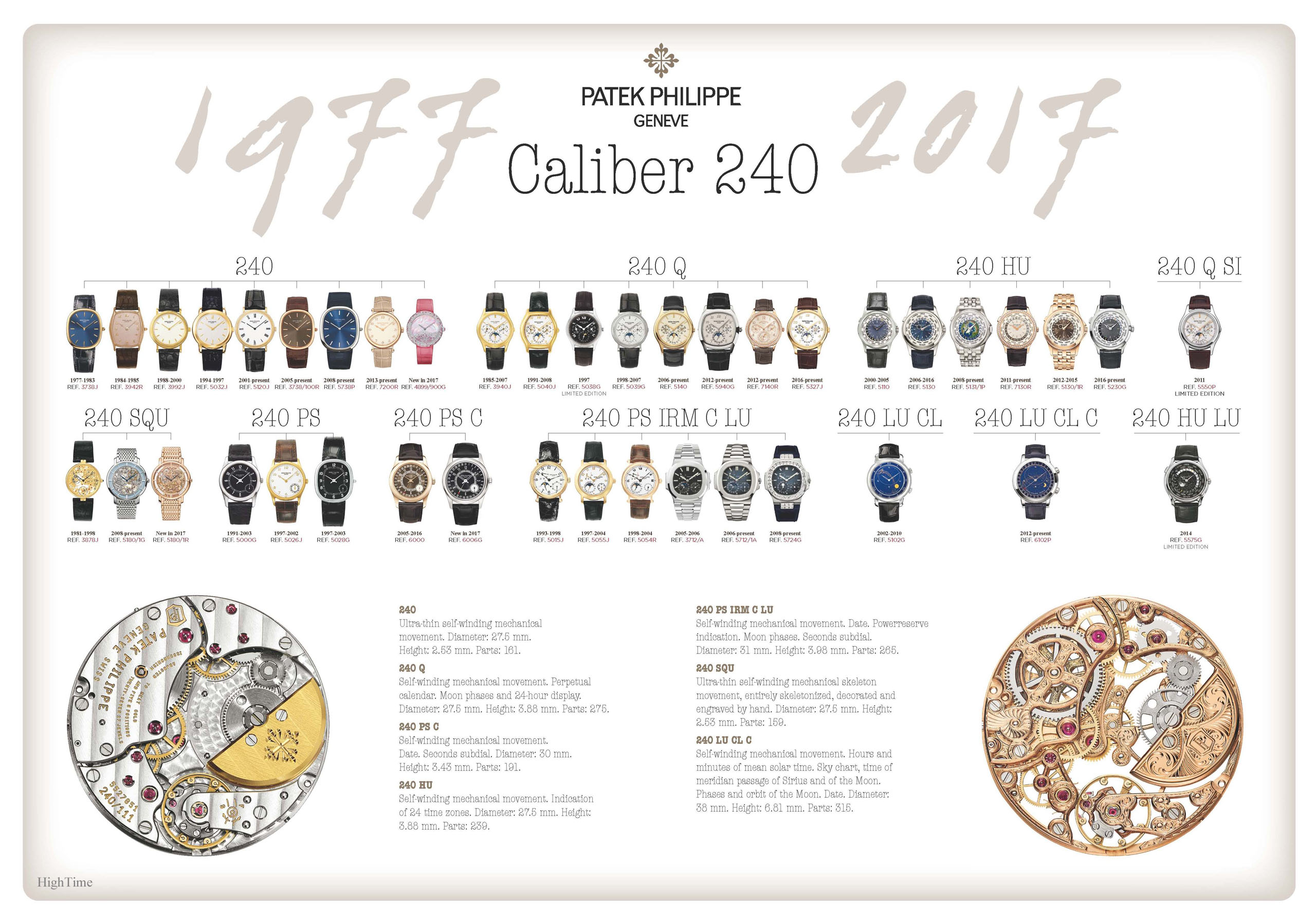
In the end, I think there is no comparision between the 240 bridges’ shapes and the new 31-260’s inside the 5236P (or 5326G). It is a sign of times and a nice evolution as more and more people come into watches, hence start to feel they would like to learn more about watch making and finishing in particular. How it has been done here is a good way to differentiate the 31-260 we find in the 5235 (with the Advanced Research Pulsomax) from the one equipping here such a Perpetual Calendar. We have 2 fantastic offers, the 5235 having its own “optimized accuracy-oriented” segment.
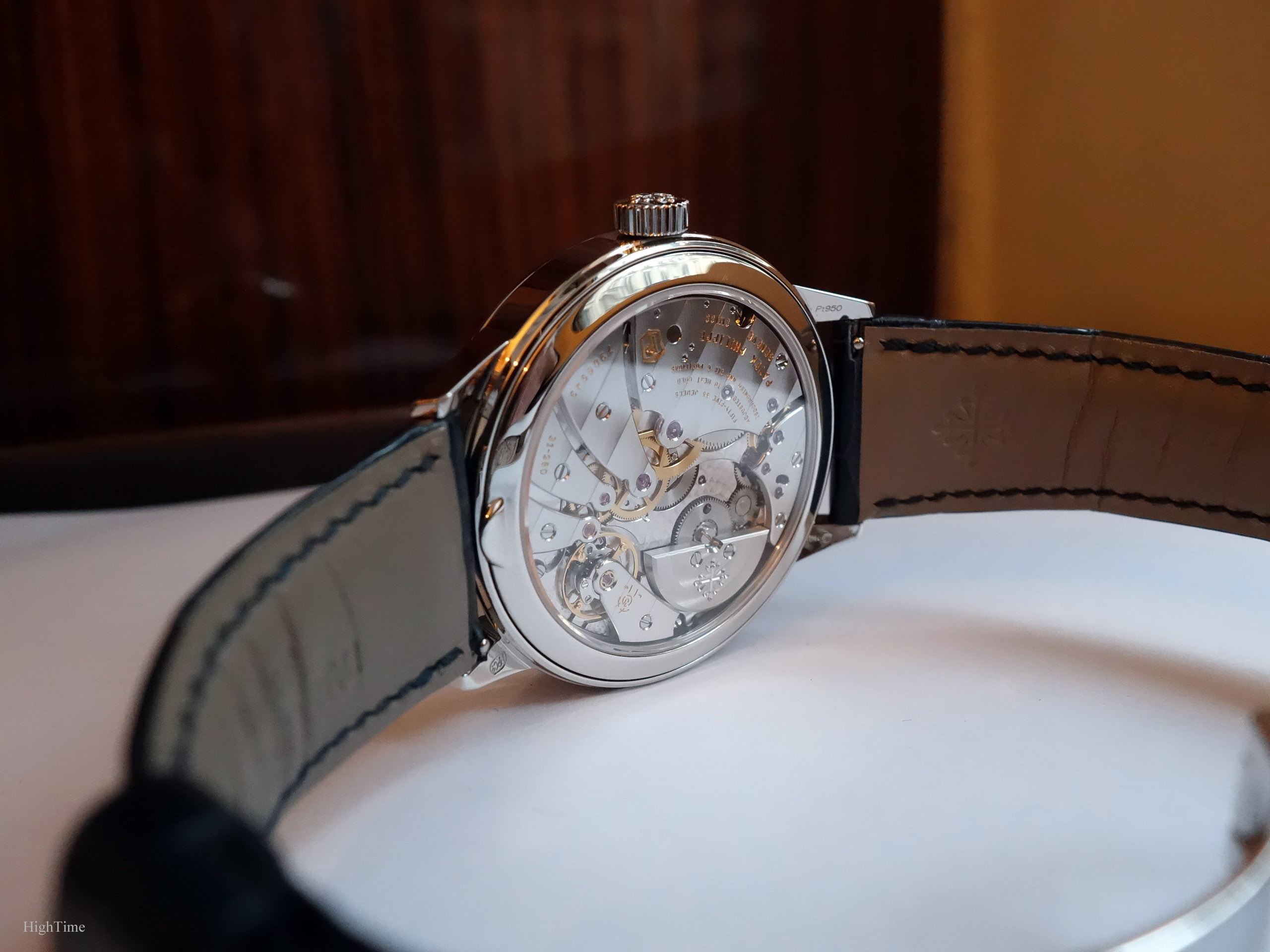
Sometimes, watch fans tend to balance between manual and automatic movements, the former being more opened thus spectacular (like chronographs), the latter being partly hidden by a central rotor or wider bridges. That’s why, in the field of self-winding calibers, the off-centered minirotor ones are particularly appreciated.
As far as the 5236P is concerned, I think that we’ve reached a peak, and maybe one of the most beautiful movements of this kind from Patek, and from established brands.
A wonderful blue masterwork
The general philosophy
I hardly ever end an article with dial and case rendering but I must recognize I have a soft spot for movement technical aspects and I think this one is important.
Of course, let’s not forget the aesthetics. To me, Patek has presented one of the most attractive blue dial series lately, especially naming the 5170P‘s, this 5236P’s or the 5205G’s. Next to black or silvery dials, the blue ones are definitely as classical and timeless (used in the past with the Ellipse or the 5070P for instance). While it is difficult to bring nuance to black, and in a lesser extent to silver, blue shows it offers a wide array of emotions through shades and materials. And I especially think they have found something outstanding with these dark blue gradient dials.

Ageing well is more a question of dial decoration pattern more than blue, grey or black color per se. For example, a very unusual or “original” dial pattern (many squares, odd shapes…) can go out of fashion more rapidly than a metallic sunburst or sandblasted one.
In the recent past, for people who could experience it in real, this “blue” appeal potential couldn’t be better illustrated than in the Nautilus. Today, blue shades are available for the classical line-up as well, with a different output. This is a smashing move from Patek, and Thierry Stern in particular whose choices are (imho, as I said in the 5327G review) sometimes unfairly questionned on that matter.
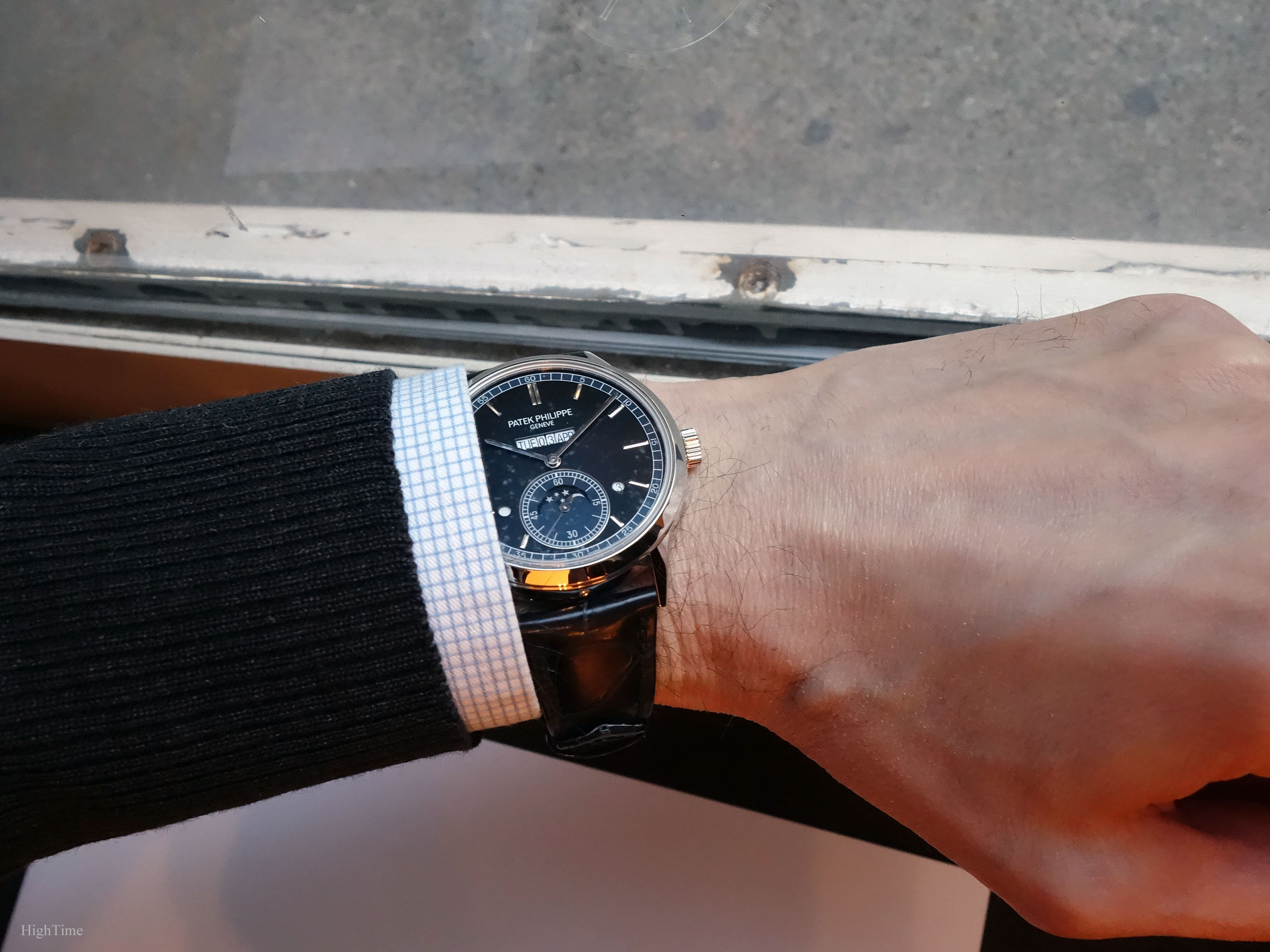
The brand’s new aesthetical philosophy is stabilized and has found its marks hence its way. All is about keeping traditional and classical together with our current times. It is indeed aesthetically recognizable as a Patek, hence doesn’t look like other brands. Patek’s uniqueness is difficult but very important to reach. The fact they have a wide complexity of cases work helps creating a personal signature as well.
In that regard, the 5236P looks beautifully elegant and classical but definitely very different from the 2000’s era (or prior). Definitely not a “grandpa’s watch” as younger clients sometimes refer to regarding too conservative brands.
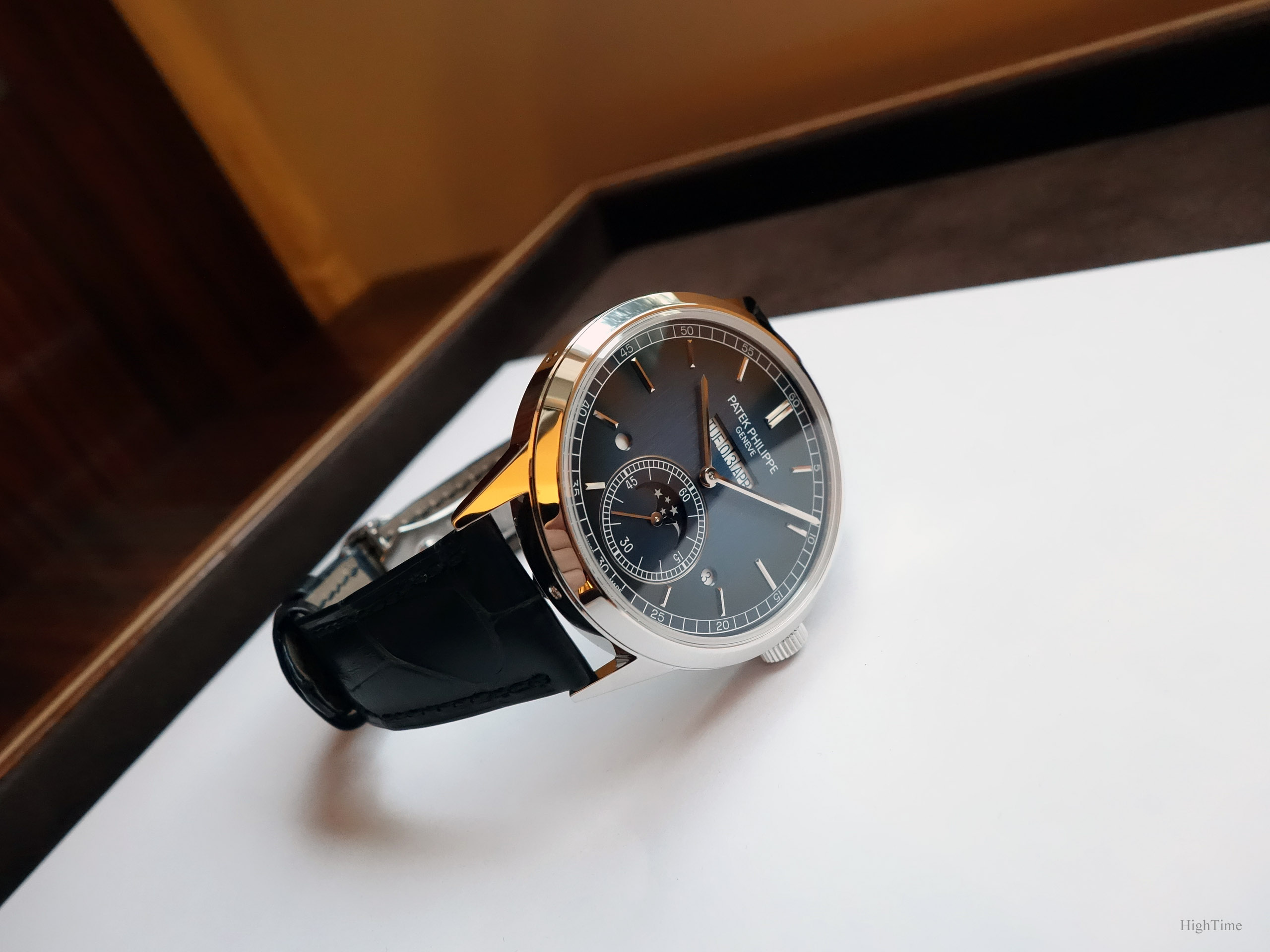
It is interesting to see they followed a similar philosophy with a very different outcome for the 3 timepieces I mentionned a little earlier. The way contrasts are used (white markings on dark dials), the gradient colors (darker outer edge) require an acquired taste not to make mistakes.
All skill, No luck, as being a long time dial maker, the brand finds continuously new means to play with dials effects and nuances.
The 5236P’s details
What we discover at first is its blue, black-gradient finish (lacquered), on a satin vertical brushed metallic dial (made of brass). While the platinum case is 41.3mm with a quite pure dial, the white gold polished markers underline its outer limits, especially next to the darker edge color. Markers are very varied at Patek and it is a pleasure to discover how they are made when holding a new timepiece. These markers are here perfectly faceted, hence why they shine so beautifully.
The white gold stick hands are the ones we find in the first 5170G (silver dial). It is interesting to notice, depending on the colors and finishing, how different the overall piece looks: very pure and quite cold in the chronograph while being an element of the 5236P’s understated elegance. They are homogeneous with the markers’ orientation and width and could rightly be the best choice for such watch and dial. Dauphine or leaf hands might have indeed been an incoherent move vs straigther/more angular lines. Yes, it is a traditional brand, but it definitely shows they are king in this territory, mastering all skills of elegance.
Several white markings add the casual and more modern touch that suits today’s evolution of dial aesthetics. Those printings look so sharp and thin, they are a real treat to look at. I particularly like the subsidiary dial scale arrangement (at 6): more concentrated in the exterior (white scale), bluer in the middle, focusing on the nice moonphase dial. In addition, this subdial receives a white gold ring.
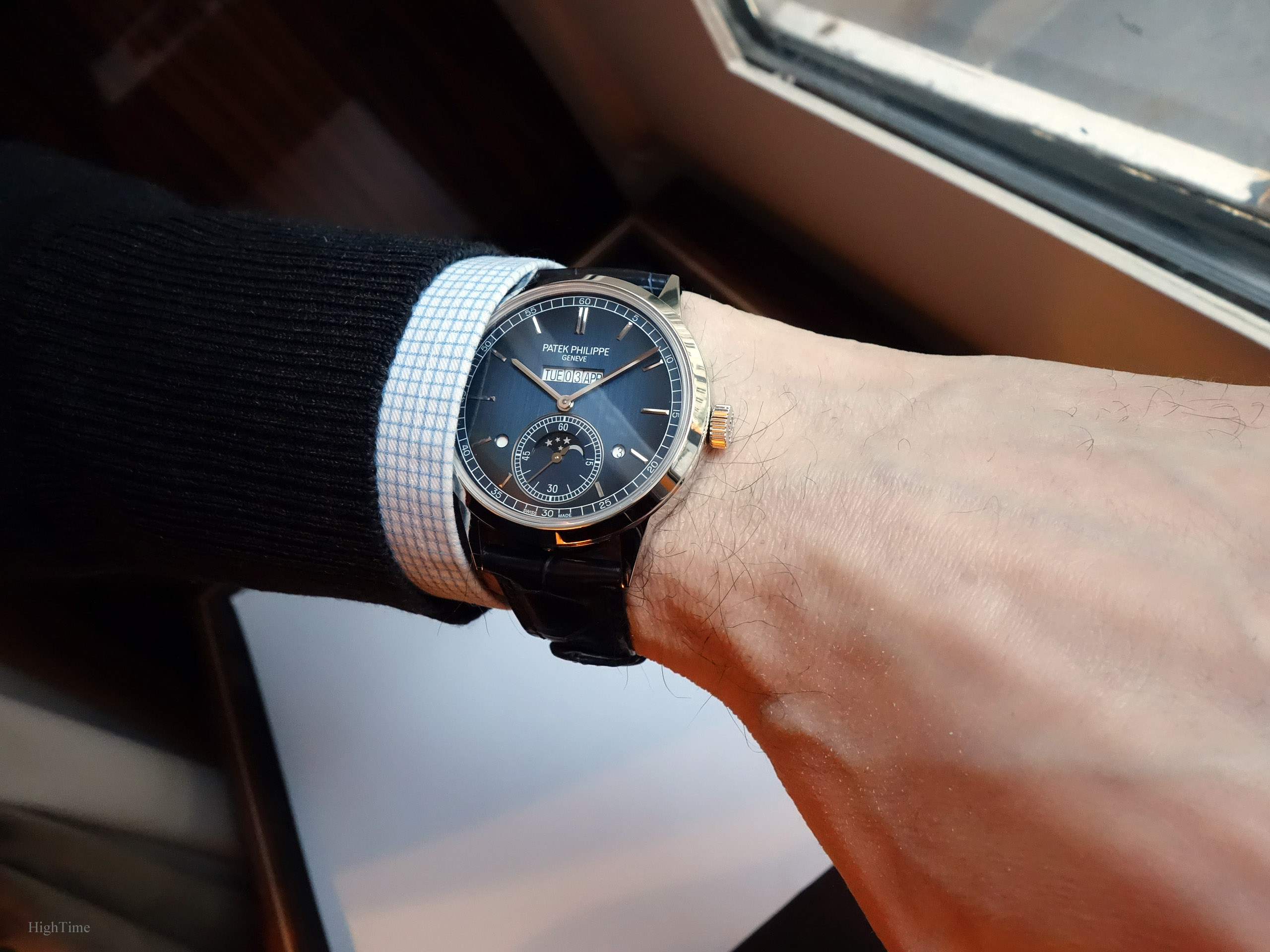
Nota: please note that the pictures showing a full dark blue uniform color are not accurate. On the contrary, the pictures showing the lighter brushed center are more faithful to the original.
Overall, you have the impression of a matte dial with shining markers and hands that communicate a very superior craftmanship standard work. This is rapidly remarkable for a trained eye. They work together and everything on the dial looks neat and sharp. I love that and I don’t think I can think of another equivalent in the collections. This dial is just unbelievably mesmerizing.
The new perpetual calendar “in-line” display, standing right under the Patek Philippe logo, is quite discreet. The markings are dark blue as well, not to mismatch with the overall spirit. The little gap between the 2 date figures is quite discreet in the metal. This was something I wanted to check after the close-up press pictures.
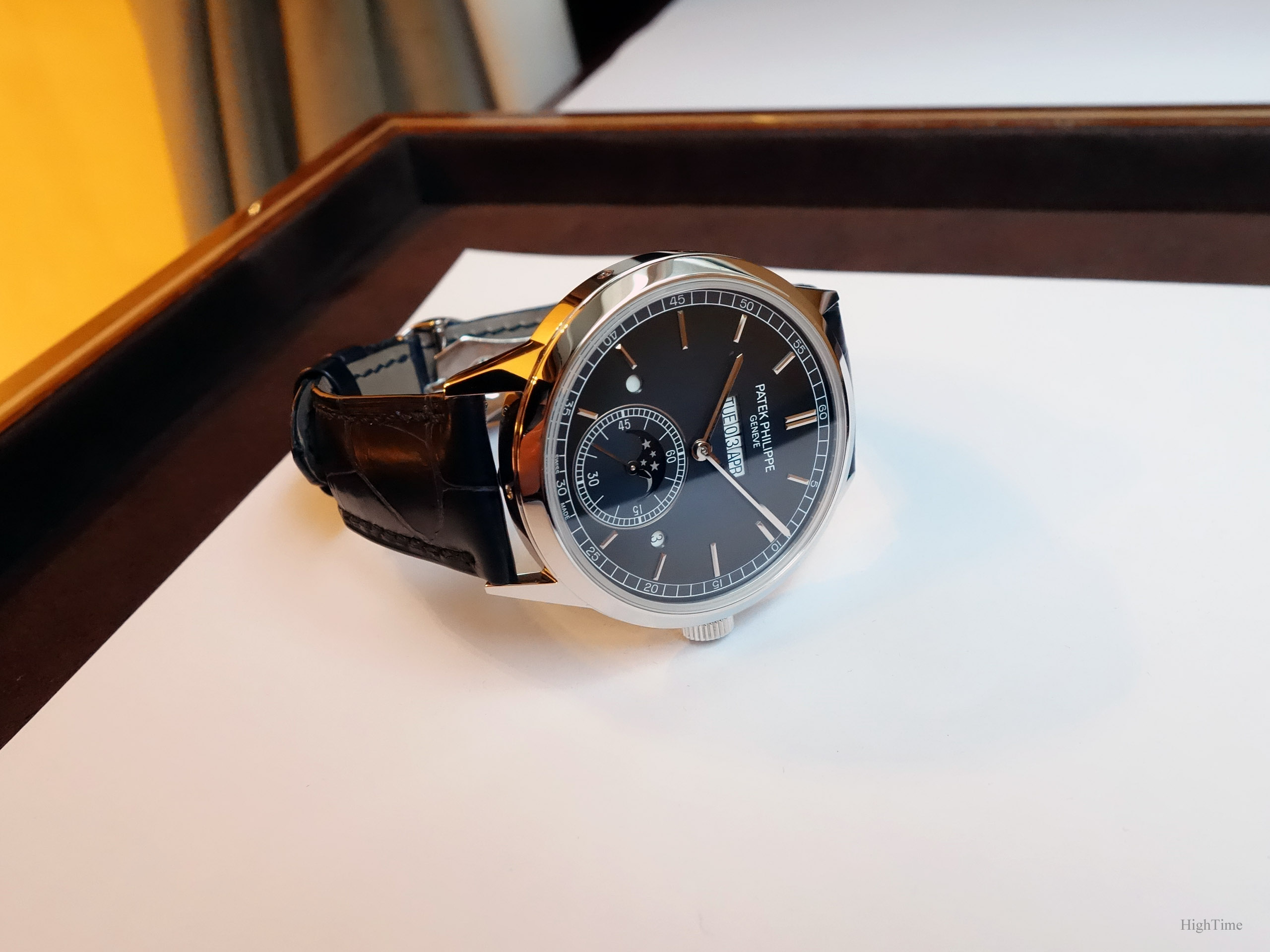
On the practical side, the way of reading the date is more natural, compared to looking for each of the items at different places. Of course, the month isn’t what we need to read everyday, but day+date rather is.
The 41.3 x 11.07mm platinum case is quite a larger size than usual for Patek considering this complication. It usually stood at 37 (5140), 39 (5327) or 40mm (5320) through the 2 last decades. With increasing wrist sizes, new clients in terms of geographical origins or cultural background naturally influence the offer (like with the 5905’s or 5524 Pilot’s 42mm). The new 5236P can widen the rather small Patek offer in that field.
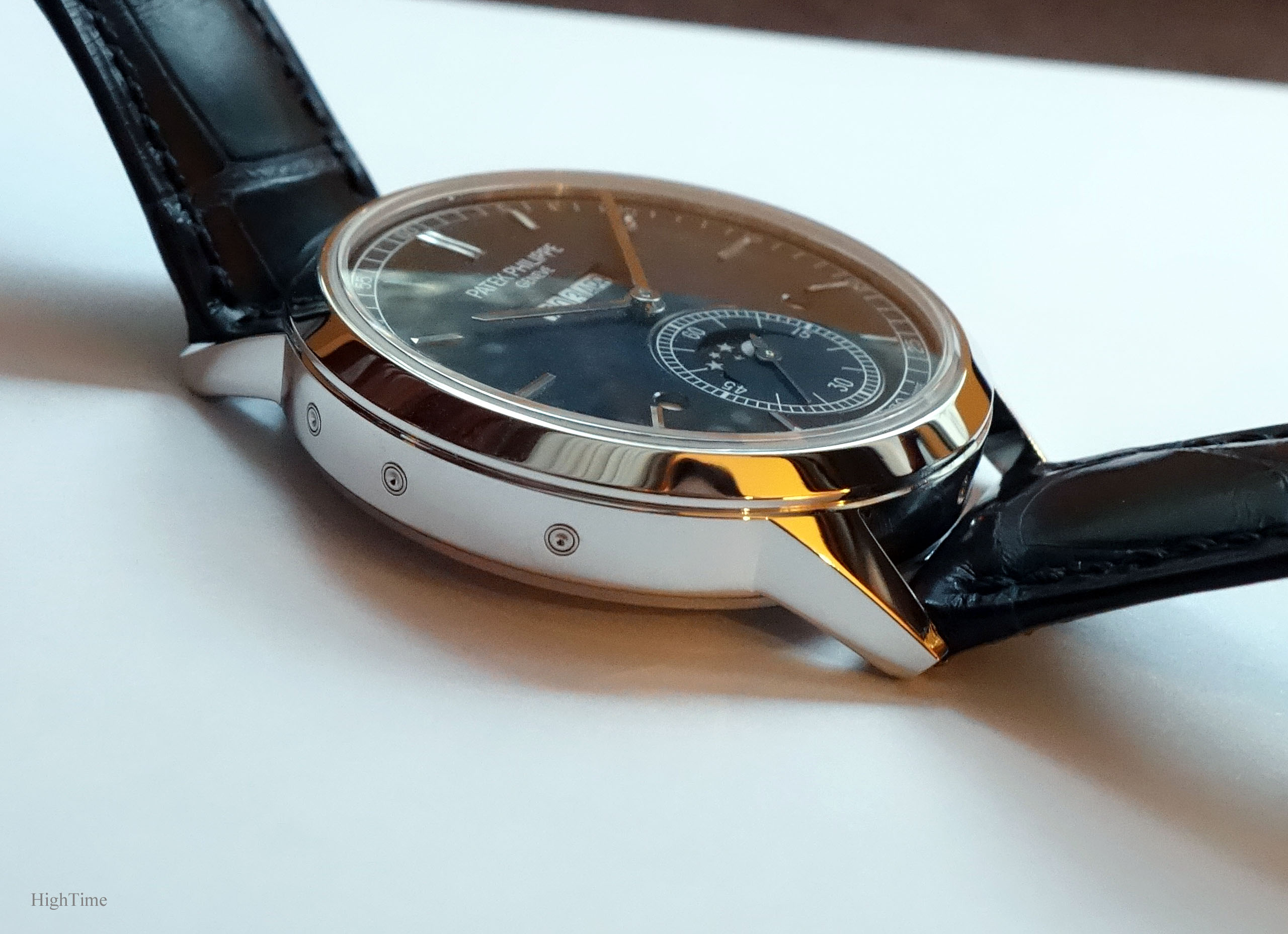
However, as visible on these photos (except when the camera is too close), let’s emphasize the fact that it doesn’t look big on the wrist (especially on mine, 16cm). The lugs aren’t too long so the watch sits well on smaller wrists. Furthermore, it is still 0.06mm thinner than the 5320G.
Patek rhymes with comfort on so many models, even when heavy (complicated and/or Platinum). This is often overlooked but lack of comfort can be a reason to get rid of a watch.
Aesthetically, the case is fully polished whereas the gold 5235s show brushed caseband and lugs’ sides. By the way, I can’t think of a platinum case with brushed parts except the specific 5370P? Maybe a question of difficulty to work with platinum (30% harder than gold). Anyway, if the owner might want to be particularly careful regarding hairlines in that context (especially when pairing with popular bracelets and decorative bangles), the whole watch is mega-attractive. Note the slightly recessed bezel that is a very nice aesthetical move to work with the case. It also lowers the dial’s width, hence the watch’s width.
In other words, forget all the press-release photos, I don’t think you imagine how beautiful this watch looks in the metal.
As usual, the little “signature” diamond at six reminds the wearer of its metallic nature, hence exclusivity.
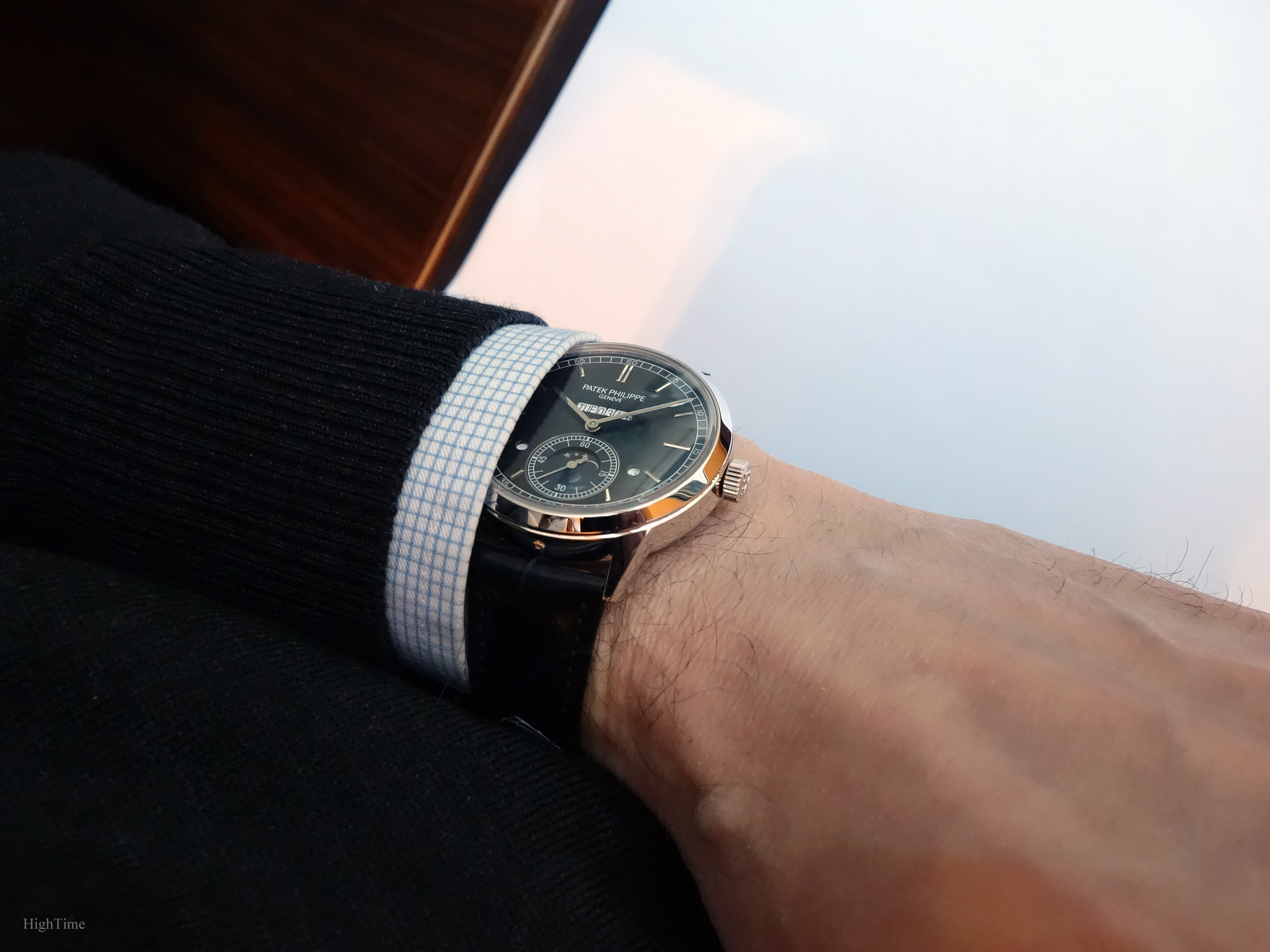
This Perpetual Calendar is provided with both a Sapphire and a solid snap-back and it provides a 30m water-resistance.
It is equipped with a shiny navy blue Alligator leather strap with its Platinum fold-over clasp.
Conclusion and Thoughts
With several novelties released in the last decade, Patek Philippe is creating a new visual yet distinct identity with the 5235 and 5236 references; back to the kind of “aperture”-styled QPs. Over a whole century, from the first unique model housing the famous 97’975 movement (visible at the Patek Museum), Patek has faced the turbulences of History, standing the test of time when the winds blew the other way round. Especially in a world of heavy luxury marketing.
The Patek Philippe 5236P is another reference (case family) but it is more importantly a totally new display format, that required a deep redesign and search for energy efficiency in order to fuel this legendary complication. This is a part of Patek Philippe’s deep assets on the long run, thus its significant influence on watchmaking.
I know I often say this, but I loved this piece (yes, surprisingly, I tend to write articles about what I like).
There are years when I don’t feel I’m that excited by the offers. The 5236P Perpetual Calendar is a piece I’d dream to get. It is definitely something I’m attracted to because it looks marvelous, it glitters (not too much) and, in the end, it fascinates, thanks to the dial colors the brand now fully masters in this new casual-elegant atmosphere. Above all, its movement is a new step-up from the last decades in the field of automatic-wind QP calibers (and now in the 5326G too).
Last but not least, 31-260 (5236P or 5235), 30-255 (6119 presented in 2021), 29-535 (manual chronograph), 28-520 (automatic chronograph)… They are last decade’s expression of Patek movements’ evolution (next to the “Übber” complications of course) and this improvement is massive.
They have come to an accomplished work and there aren’t many better ways to say it than with a Perpetual Calendar. Because indeed, I don’t think people have realized it yet, but it is another significant landmark in the brand’s history and might be one of their most accomplished Perpetual Calendars ever (technically and aesthetically).
Here is the Perpetual Calendar references rich Timeline from Patek Philippe:
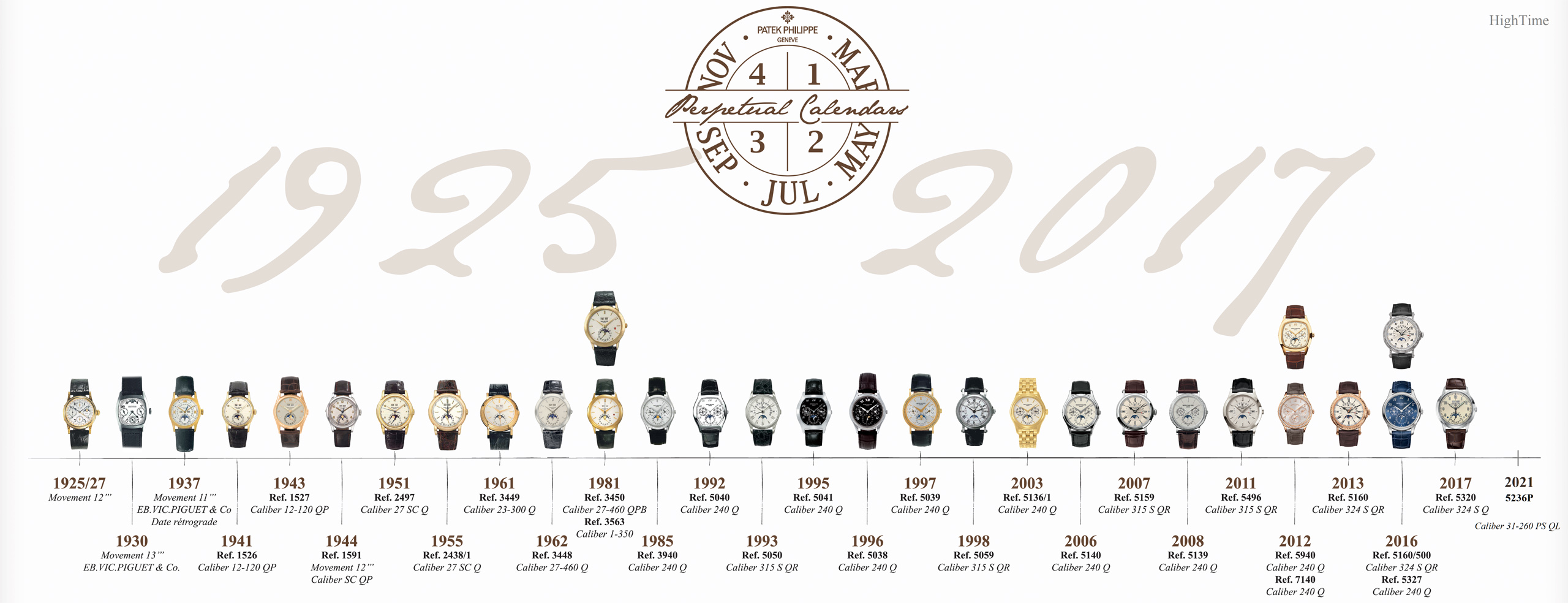
I really invite you to have a look at this thorough video about the 5236P mechanism, originally commented by Mr Barat, Head of Watch Development at Patek Philippe:
The 5236P presented in detail by Mr Barat
A quick video (<2min.) of the movement’s assembling:
Assembling of the 31-260 caliber
An inside travel into the 31-260’s Perpetual Calendar module (<1min.):
Video into the 5236P’s caliber
And 2 small visual presentation videos from Patek:
Video 1 of Patek’s quick 5236P presentation
Video 2 of Patek’s quick 5236P presentation
The Patek Philippe 5236P’s MSRP is 121 700 € (VAT incl.) as of today (2022) and you can find more details about it here:
The Patek Philippe 5236P on the official website
Or a link to the 5236P’s page with several videos on the complication, etc :
5236P’s special page with videos on the official website
I hope you enjoyed the read!


